
July/August 2024 Douglas Fir Die-Off In Southern Oregon Gives A Glimpse Into The Future Of West Coast Forests



July/August 2024 Douglas Fir Die-Off In Southern Oregon Gives A Glimpse Into The Future Of West Coast Forests

“Aside from the excellent Applegate wines I’ve had from producer, Vineyard, made such an impression on me over the last few years that I from the July the attitude, which are
“But Aside from the excellent Applegate wines I’ve had from Willamette producers, the wines of one producer, Troon Vineyard, made such an impression on me over the last few years that I drove seven hours from the Mendocino Coast in July to pay a visit to Applegate Valley, While I admire the way Troon farms and its empirical attitude, the proof is in the wines, which are invariably fresh, lively and expressive,”
—Eric Asimov The New York Times
—Eric The York
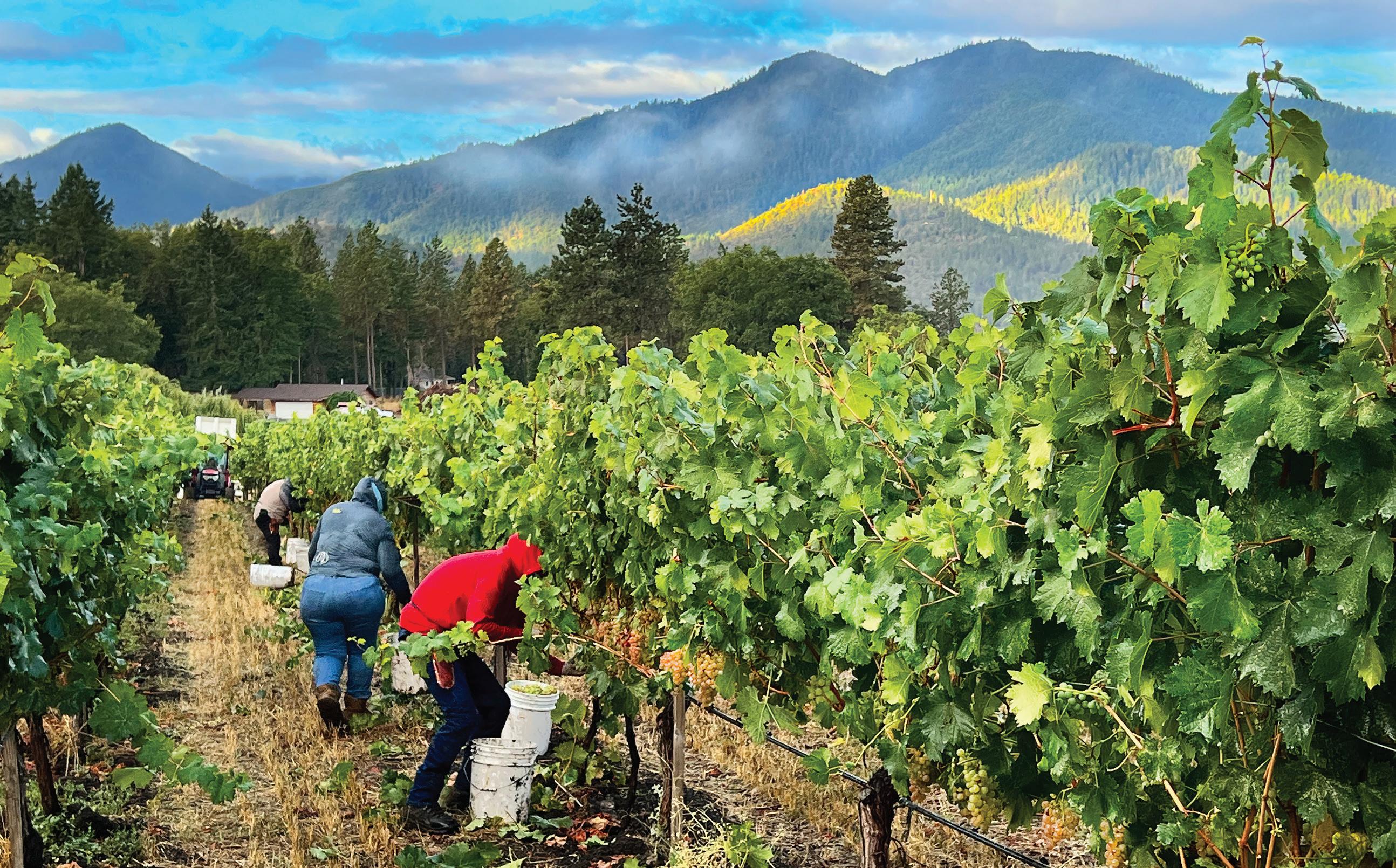
JPR Foundation
Officers
Ken Silverman – Ashland
President
Liz Shelby – Vice President
Cynthia Harelson –Medford/Grants Pass
Treasurer
Andrea Pedley – Eureka
Secretary
Ex-Officio
Rick Bailey
President, SOU
Paul Westhelle
Executive Director, JPR
Shelley Austin
Jefferson Live Executive Director, Ex-officio
Directors
Eric Monroe – Medford
Ron Meztger – North Bend
Rosalind Sumner – Montague
Dan Mullin – Eugene
Margaret Redmon – Redding
Karen Doolen – Medford
JPR Staff
Paul Westhelle
Executive Director
Darin Ransom
Director of Engineering
Sue Jaffe
Membership Coordinator
Valerie Ing
Northern California Program Coordinator/Announcer
Abigail Kraft
Business Support Manager/ Jefferson Journal Editor

Geoffrey Riley
Assistant Producer/
Jefferson Exchange Host
Erik Neumann
News Director/Regional Reporter
Dave Jackson
Music Director/Open Air Host
Danielle Kelly
Open Air Host
Soleil Mycko
Business Manager
Angela Decker
Jefferson Exchange Senior
Producer
Charlie Zimmerman
JPR News Production Assistant
Zack Biegel
JPR News Production Assistant
Calena Reeves
Audience & Business Services
Coordinator
Liam Bull
Audience Services Assistant
Vanessa Finney
All Things Considered Host
Roman Battaglia
Regional Reporter
Justin Higginbottom
Regional Reporter
Jane Vaughan Regional Reporter
Milt Radford
Morning Edition Host
Dave Young
Operations Manager
JPR News Contributors
Juliet Grable Kelby McIntosh
Don Matthews
Classical Music Director/ Announcer
JEFFERSON JOURNAL (ISSN 1079-2015), July/August 2024, volume 48 number 4. Published
bi-monthly (six times a year) by JPR Foundation, Inc., 1250 Siskiyou Blvd., Ashland, OR 97520. Periodical postage paid at Ashland, OR and additional mailing offices.
POSTMASTER: Please send address changes to The Jefferson Journal, 1250 Siskiyou Blvd. Ashland, OR. 97520
Jefferson Journal Credits:
Editor: Abigail Kraft
Managing Editor: Paul Westhelle
Poetry Editor: Amy Miller
Design/Production: Impact Publications
Printing: Oregon Web Press

By Erik Neumann
Douglas fir trees around Ashland are dying in the thousands. It’s one example of how our changing climate is affecting forests in the region. Experts are calling it a decline spiral. Others are calling it “firmageddon.”
By Jamie Hale
In recent years, the Confederated Tribes of Grand Ronde and the Confederated Tribes of Siletz Indians have created opportunities for members to reforge connections to the lands their ancestors knew intimately. Their removal from this place in 1856, an event some historians call the Rogue River Trail of Tears, has become a road map that many tribal members are retracing into the future.

PAUL WESTHELLE
Abill championed by Oregon Senator Ron Wyden that would establish federal protections for the newsgathering rights of journalists received new energy recently when the Reporters Committee for Freedom of the Press (RCFP) submitted a letter to the U.S. Senate urging it to pass the PRESS Act (short for the Protect Reporters from Exploitative State Spying Act). The letter was endorsed by 53 national news organizations.
The PRESS Act would prohibit the federal government from compelling journalists through the use of subpoenas, search warrants, or other compulsory actions, to disclose information, identify confidential sources, or provide newsgathering records except in very limited circumstances, such as to prevent terrorism or imminent violence.
The PRESS Act was passed by the U.S. House of Representatives in January under suspension of its rules, a procedure generally reserved for noncontroversial, bipartisan legislation, but has been tied up in the Senate Judiciary Committee ever since.
The PRESS Act is what’s referred to as a shield law, a law designed to protect a journalist’s privilege under the First Amendment of the U.S. Constitution. Currently, there is no federal shield law, but 40 states have enacted laws with varying degrees of protections for journalists. Both Oregon and California have shield laws in place that are considered to be strong, and California voters passed a proposition in 1980 that elevated these protections to its state constitution.
There are many benefits to enacting the PRESS Act at the federal level. It would establish a stronger and more durable standard for the U.S. Department of Justice, which currently treats journalists according to internal policy, which can change at any time. Under the PRESS Act, the federal government would be expressly prohibited from surveilling journalists by gathering their phone, messaging, or email records and it couldn’t force a journalist to disclose their sources. This protection would also extend to telecommunications companies which may store a journalist’s work product. Also, acknowledging the changing trends in journalism, the act defines “covered journalist” broadly to apply to any person who regularly publishes news or information in the public interest.
While a federal shield law would not supersede state laws, protection on the federal level would send a clear message about the importance of preserving every journalist’s independence, help minimize frivolous lawsuits which news organizations need to defend, and strengthen the relationships between journalists and their sources.
In an age when our political parties disagree about most everything, there seems to be general agreement on the value of the PRESS Act. The House bill was sponsored by Representatives Jamie Raskin (D-Md.) and Kevin Kiley (R-Calif.) and co-sponsored by a group of 18 other members, nine Republicans and nine Democrats. When it was considered in the House, no Republicans or Democrats objected to the act. The Senate version of the bill is co-sponsored by Senators Dick Durbin (D-Ill.), Ron Wyden (D-Ore.), Mike Lee (R-Utah) and Lindsey Graham (R-S.C.). Other prominent Republicans like Mike Pence, Bob Goodlatte, and Jim Jordan have supported shield legislation in the past.
In 1787, Thomas Jefferson famously wrote: “… were it left to me to decide whether we should have a government without newspapers or newspapers without a government, I should not hesitate a moment to prefer the latter.” It’s time to strengthen the essential role the press plays as a watchdog of our democracy and protect the journalists who work on our behalf to provide the information we need as citizens of a free society.

Paul Westhelle is JPR’s Executive Director.
By ERIK NEUMANN

On a clearing overlooking Siskiyou Mountain Park in Ashland, a navy-blue helicopter is making laps back and forth up the forested hillside. A long cable hangs down and on each pass the helicopter picks up three or four large trees, stripped of their branches. It ferries them down the mountain to a log truck that’s waiting below.
“They’re shooting to get 20 loads per hour. Yesterday they got 174 loads,” says Chris Chambers, the wildfire division chief with Ashland Fire and Rescue. He’s helping coordinate this project where they’re thinning trees on around 500 acres.
In areas of this forest, anywhere from 20-80% of the fir trees are dead, he says. Experts are calling it a decline spiral. Others are calling it “firmageddon.” Chambers worries it’s increasing the number of dead trees that could burn in future wildfires.
“There are many, many neighborhoods right at the bottom of the slope here at Siskiyou Mountain Park. The vast majority of what is dead are right next to those neighborhoods,” he says.
He’s also worried that a large wildfire could permanently change this forest if hotter temperatures driven by climate change make it hard for fir trees to grow back after a fire. He says this thinning work will help soften the blow.
“This forest as we know it is going away. There’s going to be a new forest in the next decade to two decades. And if we don’t stay ahead of it, then we might not have a forest in 20, 30, 40 years,” Chambers says.
The work in the Ashland watershed is aimed at the symptoms of the Douglas fir die-off. But it doesn’t explain why the trees are dying in the first place.
On a hiking trail just outside of Jacksonville, Oregon, Max Bennett is staring up at a collection of fir trees.
“We’ve tagged these trees. There’s a little metal tag on the other side,” Bennett says, peering upwards.
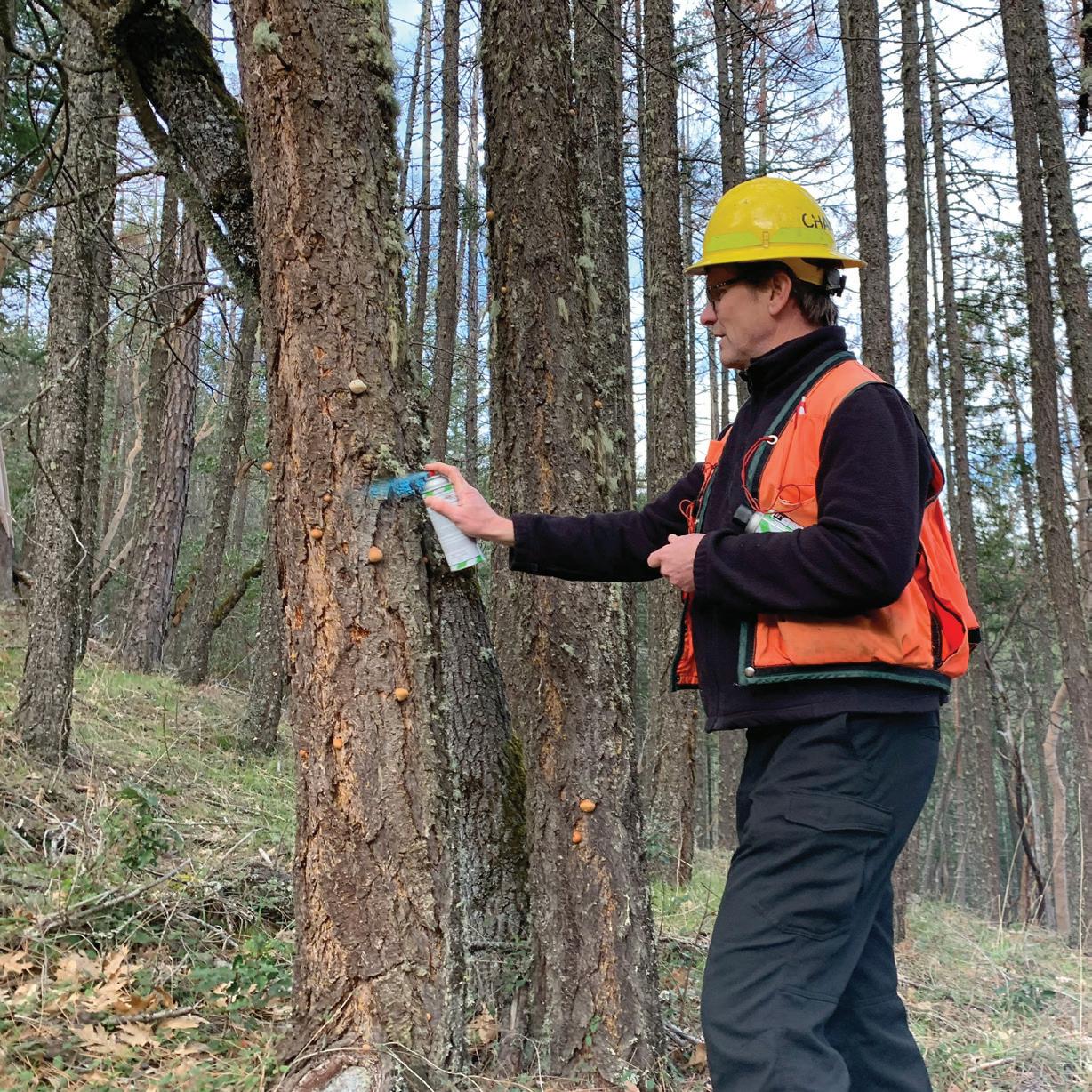
Bennett is a retired Oregon State University extension forester. He’s been researching this fir tree die-off and he co-authored a 2023 paper called Trees on the Edge. As the name of his report suggests, this forest in Jacksonville is an environment that’s right on the edge of where Douglas fir trees can grow. That means it just takes a little change in conditions -- like drought or hotter summers -- to push them over the edge.
“Those two things: not enough rainfall and higher temperatures, particularly in the summer, are what people are talking about much more now as hotter drought. It’s not just drought the way we normally think about it, its hotter drought,” he says.
That combination of above-average temperatures and below-average precipitation is stressing out Douglas fir trees. Bennett suspects these conditions are messing with trees’ ability to pull water up from their roots.
“The hotter it is and the dryer it is, the more pull; the more draw from the atmosphere. It’s like a straw. You’re sucking really hard on that straw, and instead of liquid, you draw in air,” he says. “Think of it as a tree heart attack in a way.”
Southwest Oregon is being especially affected by hot drought conditions because there’s so little water here to begin with.
If hot drought is the first factor driving the die-off, the second one is a little metallic-green bug.
On a hillside midway up Woodrat Mountain in the Applegate Valley, Laura Lowrey swings an ax into the bark of a standing dead Douglas fir tree.
“I usually try to make a square,” she says between swings. “You can peel the bark off these long-dead trees.”
Lowrey is an entomologist for the Forest Service and the Bureau of Land Management. She’s trying to look under the bark to find the squiggly tracks of an insect called the flatheaded fir borer.
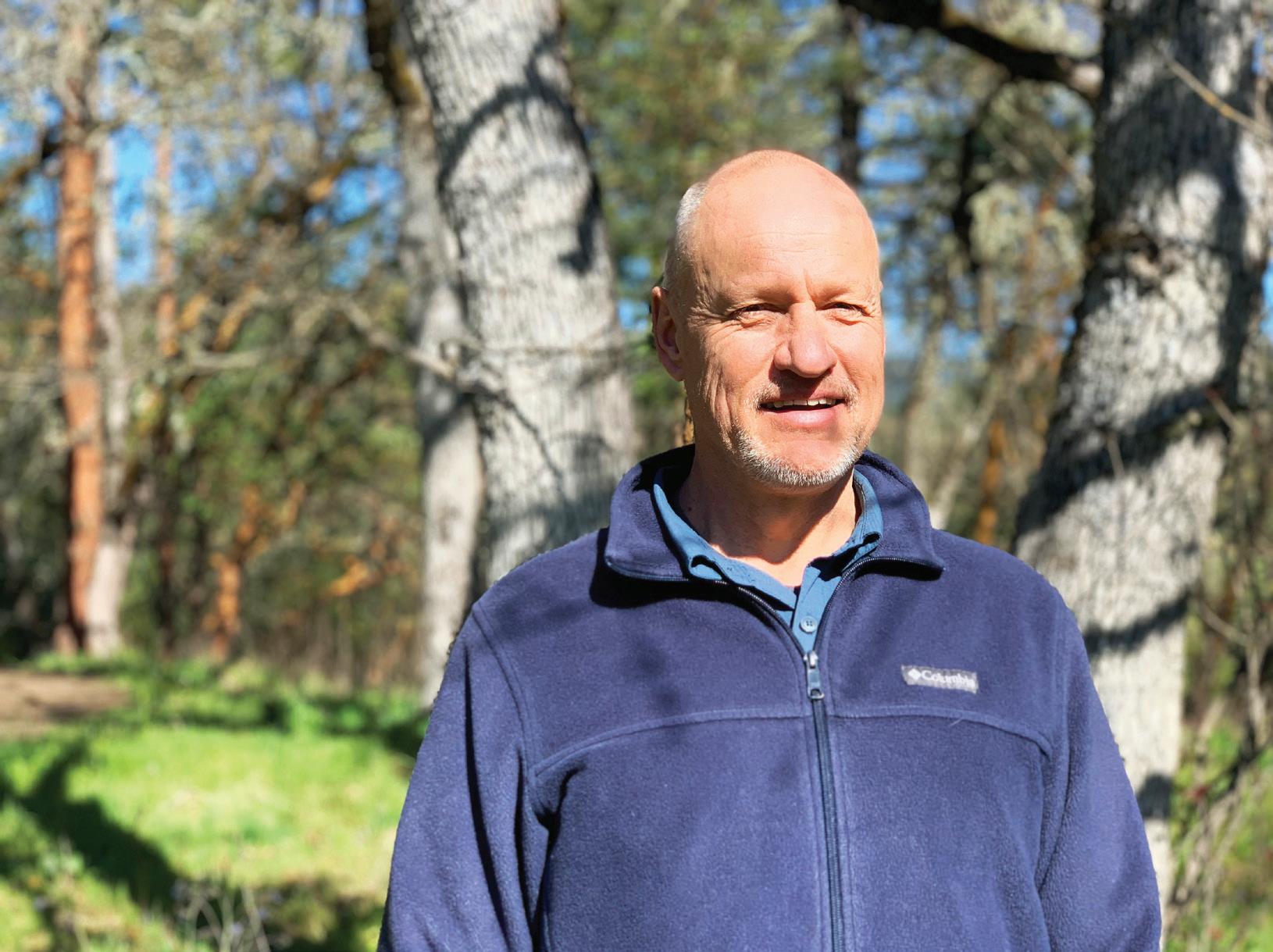
Some
Rogue Valley residents say the BLM and the City of Ashland are motivated by timber sales, not forest health or public safety.
She rips off a chunk of bark. Inside are little tunnels where the insect’s larvae have chewed. On the outside, tiny jewels of pitch or sap show where fir borers went in and the tree tried to stop them.
These bugs aren’t inherently bad.
“They are more of the cleanup crew. They’re not tree killers themselves. They’re more like, trees are dying, now they’re helping recycle them, turn them into soil,” Lowrey says.
Fir borers smell stress signals from trees that aren’t healthy, she explains. But now, with so many dead and dying trees in the area, the beetle population has exploded; it’s even overwhelming healthy green trees.
Before Oregon, Lowrey worked in Idaho and the Rocky Mountains where she studied other types of beetle outbreaks. She says they went in cycles: the outbreak would grow, then peak and then crash as predators caught up.
“Here, we don’t get the sense that this outbreak is crashing,” she says.
In Trees on the Edge, for which Lowrey contributed aerial survey work, the acres with Douglas fir mortality attributed to the flatheaded fir borer jumps from a high of about 50,000 acres in 2019 to around 375,000 acres in 2022.
Lowrey has done aerial surveys over all types of federal lands across Southern Oregon, scanning out of plane windows for dying firs. She says when she moved here just four years ago there weren’t nearly as many stands of dead trees.

left: Retired Oregon State University
“We’re like, ‘Wow, it’s very fast. It’s real time. Watching the effects of climate change in real time,’ which is an odd feeling to say the least,” she says.
In response to the fir die-off, the BLM is doing thinning on 5,000 of the 876,000 acres managed by the Medford District. Officials say the projects will be meant to protect communities and roads. They’re planning to cut down trees, some of which will be sold as timber. They’ll also do prescribed fire operations. The BLM’s proposed environmental assessment for the project will be released in early summer which the public can comment on.
But some Rogue Valley residents say the BLM and the City of Ashland are motivated by timber sales, not forest health or public safety.
“One of our contentions is what they’re calling hazard tree removal, is starting to look, feel and function much more like unit logging and much more like broadscale clearcutting than clearing hazards adjacent to the road,” says longtime Applegate resident Luke Ruediger.
He argues that these beetle-killed trees would be better left as standing snags for animal habitat like birds that eat the fir borers. And, he says, these same areas have been thinned in the past. He believes aggressive forest management now will make the area more vulnerable to drought and beetle mortality in the future.
“I don’t think it’s a coincidence that right now the areas being targeted for salvage logging are also some of the areas that have been the most heavily managed by the BLM, by the City of Ashland, and by the Rogue River-Siskiyou National Forest,” Ruediger says.
A better way to protect communities, he argues, is to help residents who live around these forests create defensible space and take steps to harden their homes from the risks of wildfires.

Five miles north, in Central Point, Bryan Reatini is standing in a big green grid of Douglas fir trees in the middle of a farm field. He examines a tag on one of the trees.
“This block is “Oregon Cascade low,” which makes sense. This is around where we are at locally,” he says.
Reatini is a geneticist with the Forest Service and he’s at JH Stone Nursery. The trees here are examples of Douglas fir that have been cultivated from different seed sources across the species’ range. The grid is part of a project to study climate adaptation so that land managers across the West Coast can help forests withstand future climate scenarios.
He walks into one section where the firs are not looking great. They’re scraggly and stunted. Some have gone from green to orange.
“Washington coast,” he says. “A very different environment. And as you can see, they’re not doing very well here, are they?”
There’s wide genetic diversity, even within a single species like Doug fir, he explains. Fir trees that are adapted to the Washington State coast are not suited to Southern Oregon. But others from warmer climates might grow better here as temperatures increase.
“By transferring seeds from those environments that have adapted to those conditions, to where those conditions exist now presently, we can essentially help trees track climate change,” he says.
The steps they’re taking are conservative. They might plant seedlings just a thousand feet higher in elevation from their original source. Researchers are trying to mimic how trees would naturally shift, he says, if climate change wasn’t happening so fast.
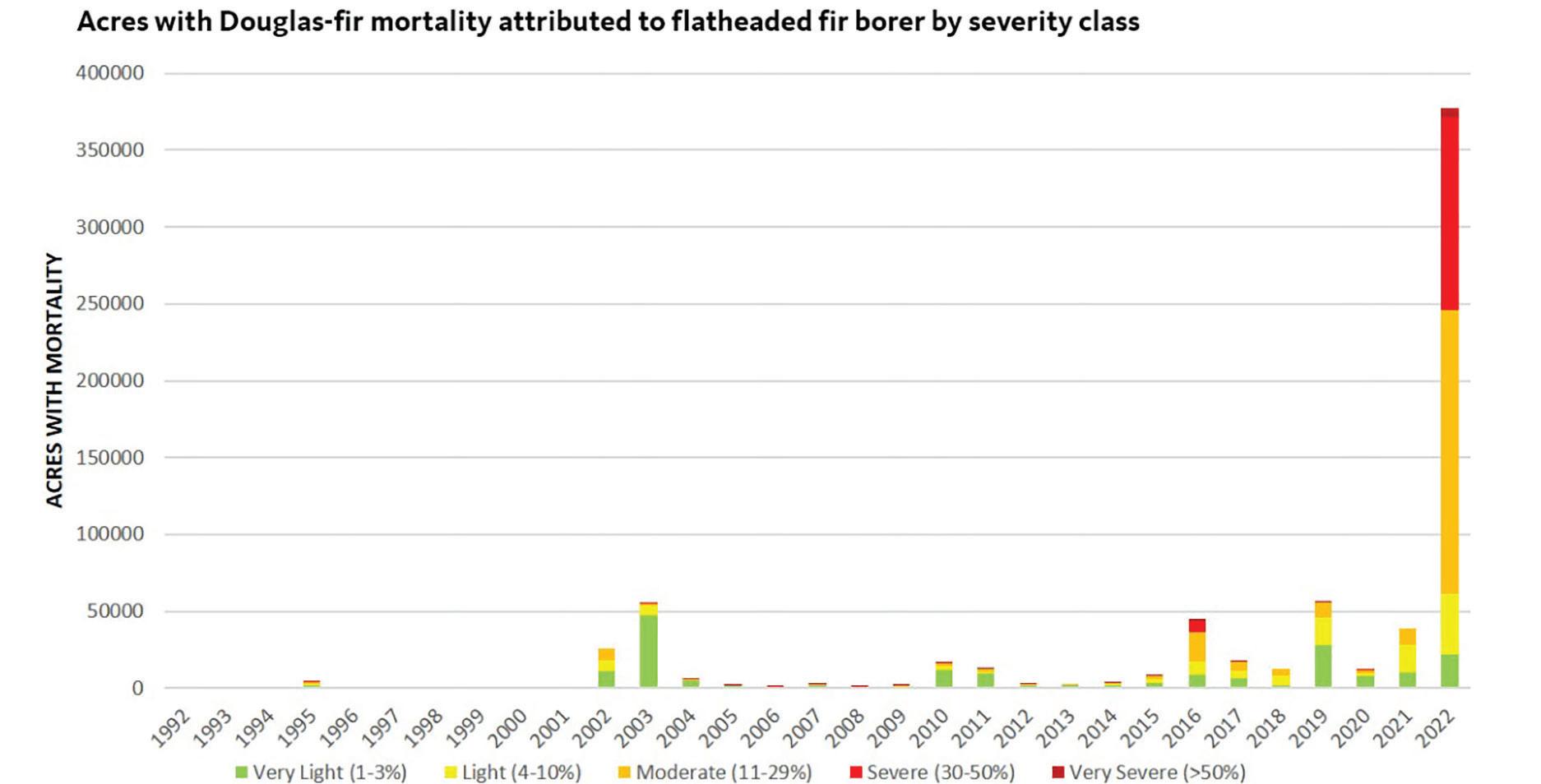
A graph published in Trees on the Edge: “Acres with Douglas-fir mortality attributed to flatheaded fir borer by severity class. The estimate for the number of acres affected is based on aerial sketchmaps that show the general areas Douglas-fir dieback has occurred. It does not necessarily mean that all or even most of the Douglas-fir trees in those areas have been killed. Instead, the estimate represents a mosaic of trees that were recently killed and living trees. Aerial survey data are most appropriate for monitoring damage and mortality trends at a watershed scale. They do not provide precise estimates of the number of trees killed or the area affected.”
LAURA LOWREY VIA MAX BENNETT/U.S. FOREST SERVICE, OSU EXTENSION SERVICE

The bigger goal for Reatini’s team is to help land managers plan ahead when reforesting places like the hills around Ashland or the Applegate Valley.
“I think we have our work cut out for us for sure. I think we’re behind and things like the Douglas fir decline spiral are examples of that. But I am optimistic that we are going to be able to maintain healthy forest populations. It’s going to require a lot of thinking and a lot of effort and a lot of innovation but yes, I absolutely think we can accomplish that goal,” he says.
In the years ahead, he says, they expect to see changes to tree species’ ranges. Douglas fir trees in Southern Oregon are just one example where the effects of climate change will slowly be revealed.
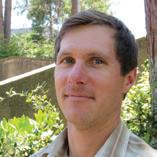
Erik Neumann is JPR’s news director. He earned a master’s degree from the UC Berkeley Graduate School of Journalism and joined JPR as a reporter in 2019 after working at NPR member station KUER in Salt Lake City.
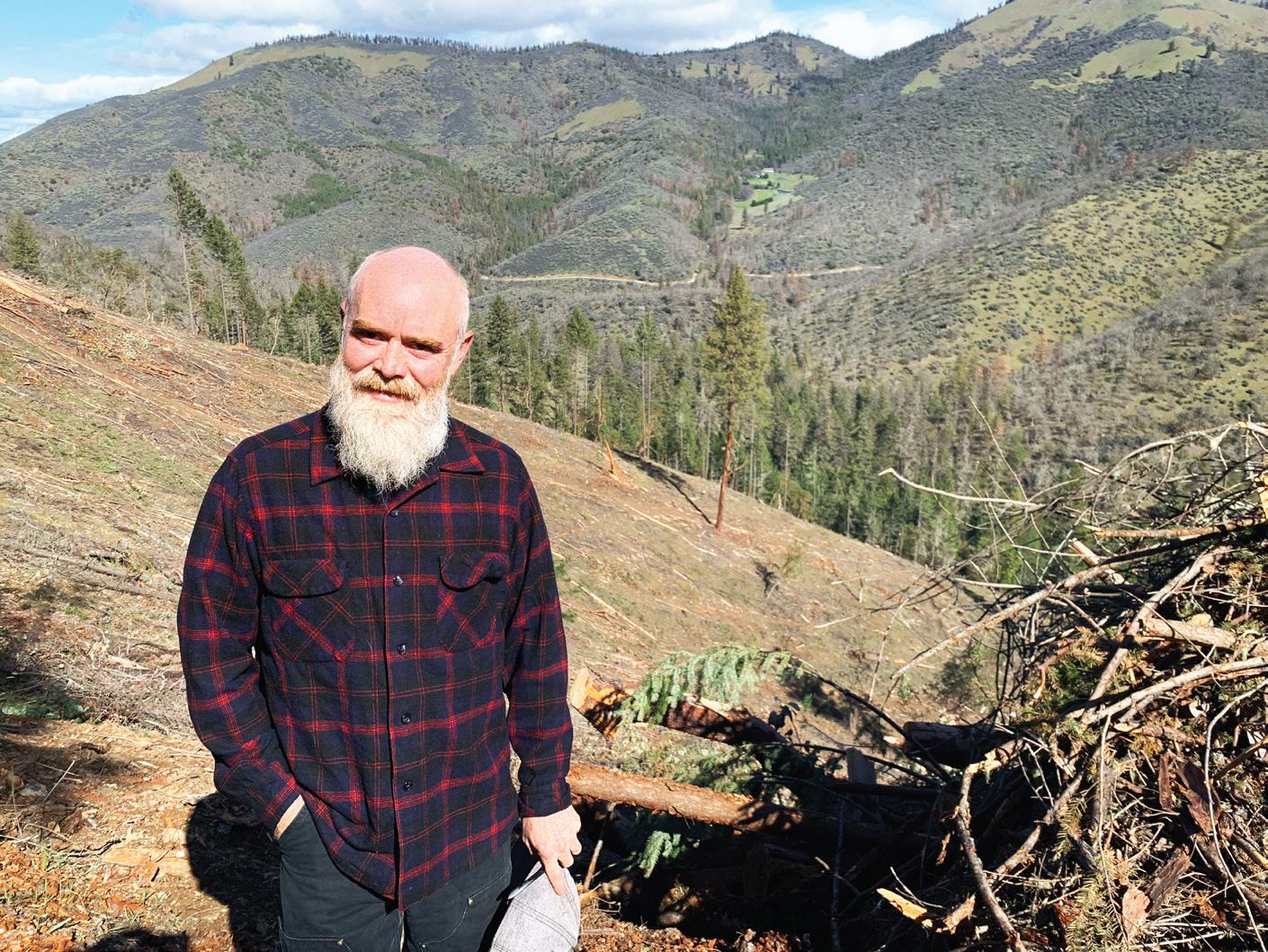
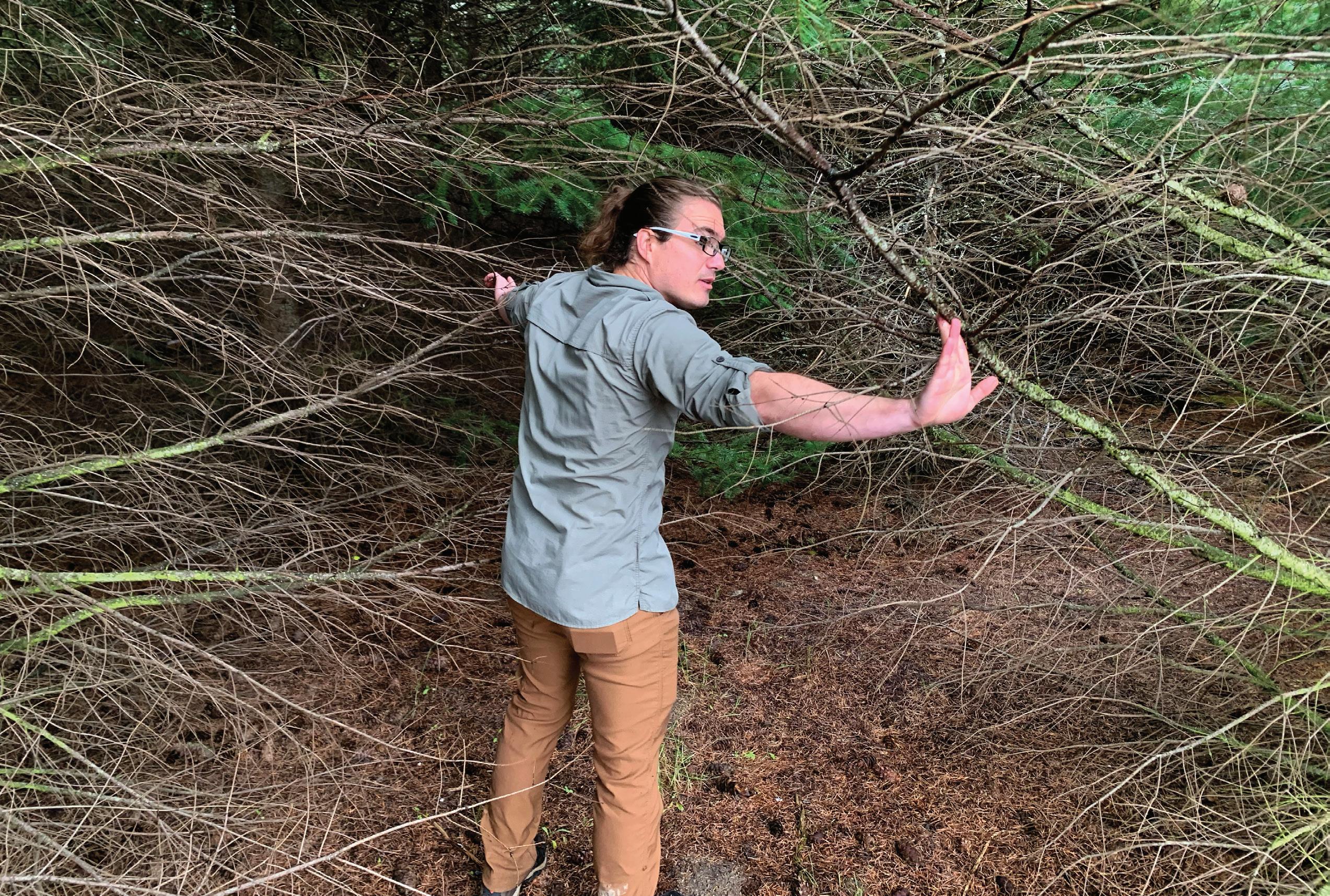

“I had never used the bus and had no idea where to start. RVTD’s Travel Trainer showed me the way—from setting up my Umo account to understanding the routes and transfers.” — Gene
Getting there together since 1975.

By JAMIE HALE
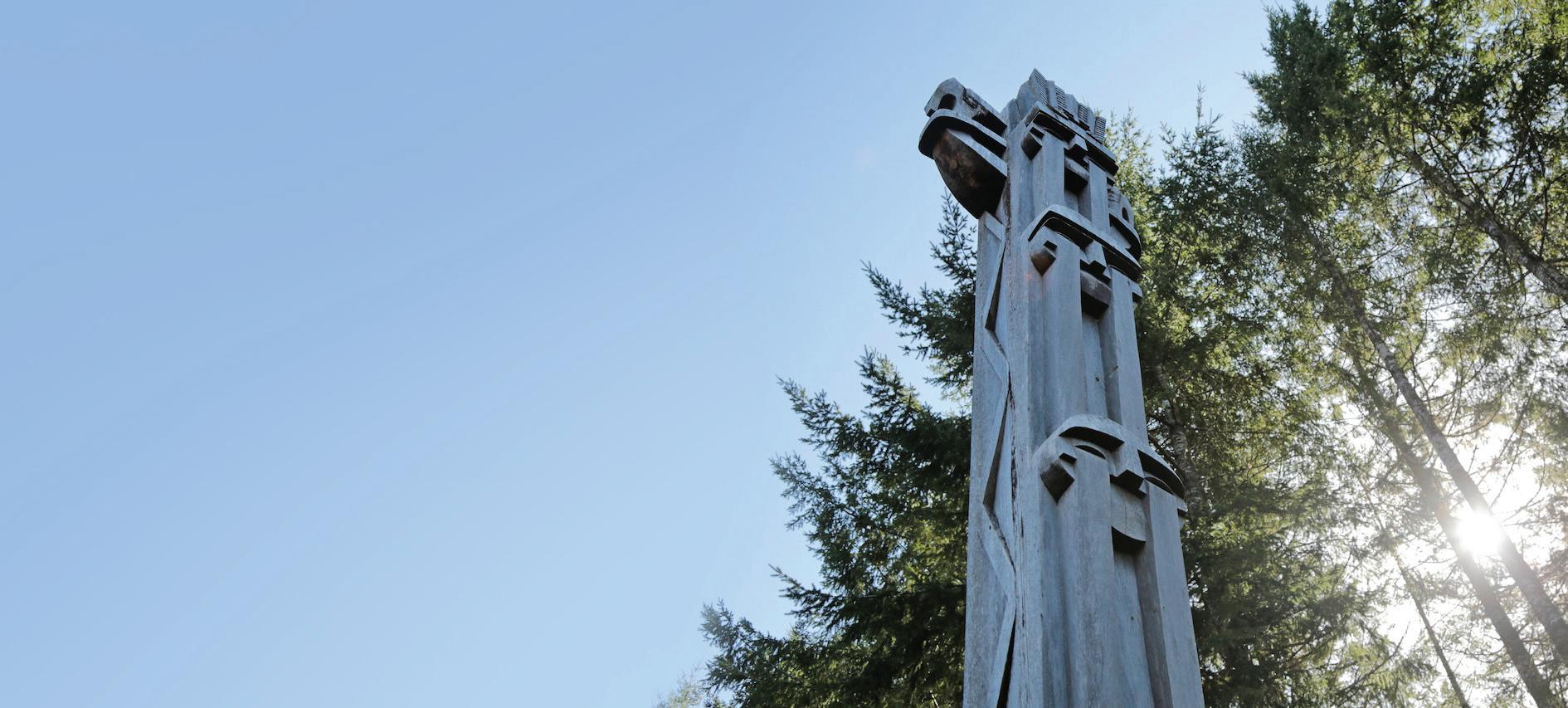
Forged by an explosive volcanic eruption in southwest Oregon, Table Rocks took their shape over millions of years, carved by the steady waters of the Rogue River, which now flows more than 800 feet below the rim.
Every autumn, as temperatures drop and rainclouds return, acorns fall from oak trees that surround the pair of flattopped mesas. The return of the acorns precedes the return of Native peoples, who gather the bitter nuts, grind them up and turn them into a nutritious mush – a practice that goes back millennia.
In recent years, the Confederated Tribes of Grand Ronde and the Confederated Tribes of Siletz Indians have created opportunities for members to reforge connections to the lands their ancestors knew intimately. Their removal from this place in 1856, an event some historians call the Rogue River Trail of Tears, has become a road map that many tribal members are retracing into the future.
In the fall, the two tribes come together to gather acorns at an event called Acorn Camp in southwest Oregon. This June, they will host their first joint Camas Camp, where they will harvest camas lilies and other spring plants. And, just after Memorial Day Weekend, the Siletz tribe will host its annual Run to the Rogue marathon, a 216-mile relay down the coastline and up the Rogue River.
Greg Archuleta, cultural policy analyst with the Grand Ronde tribe, said the current focus is on refamiliarizing tribal members with the places of their ancestors, as well as passing down practices that have survived for generations.
“Our primary focus right now is really to get tribal members out on the landscape,” Archuleta said. “It’s all about presence.”
That presence has also created a new sense of home for many Indigenous families who have spent generations living elsewhere – on reservations far away, in bigger cities or out of the region altogether.
“It’s kind of like meeting a relative that you’ve heard about for a long time but never had a chance to meet,” Robert Kentta, tribal council member for the Siletz tribe, said of returning to southwest Oregon. “That connection is still there.”
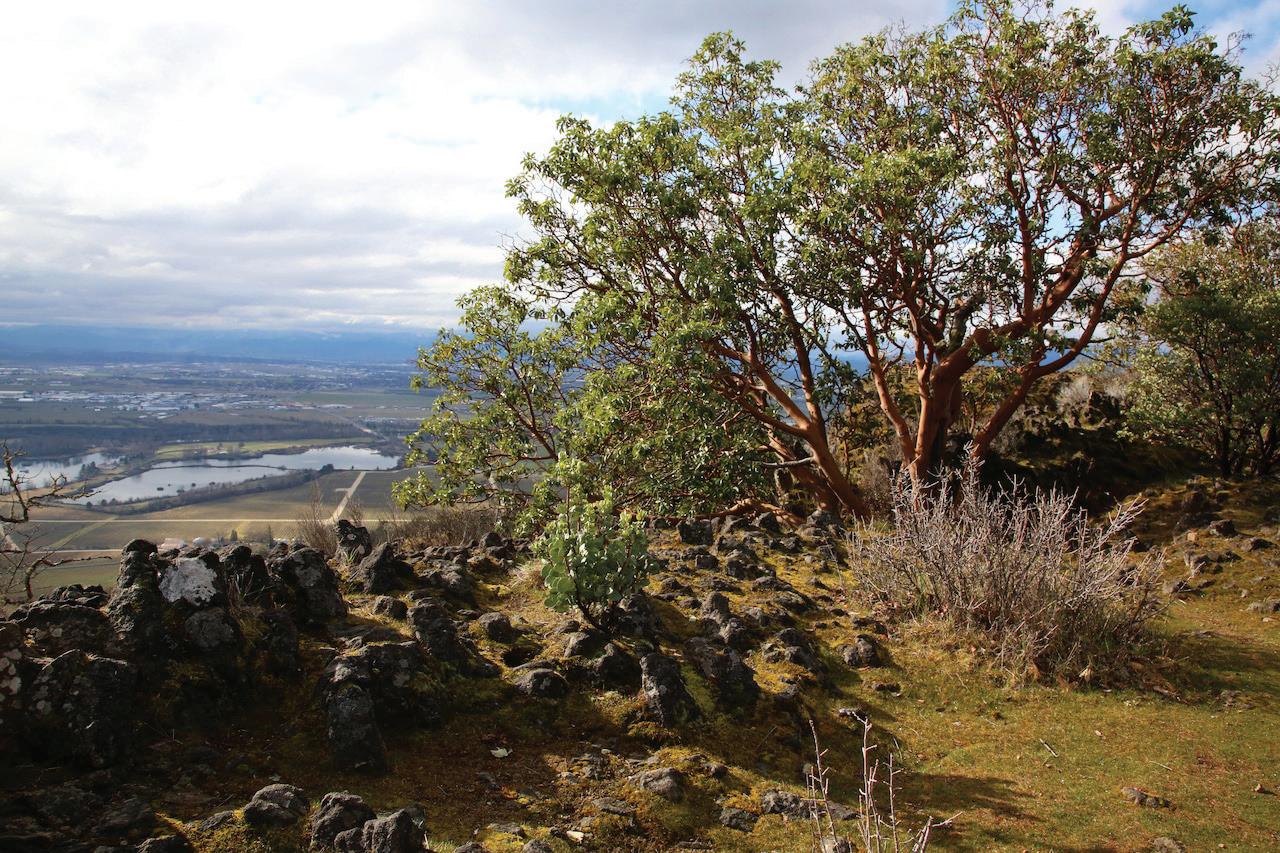
For tribal members, revisiting Table Rocks isn’t always easy. There is trauma there, buried in the ground, filling the recesses of the hard, volcanic rock.
At the start of the 19th century, the region was home to the Takelma, Shastan and Athabaskan peoples who had lived in the area for untold generations. But it was also becoming home to a growing number of non-Indigenous settlers. The first to arrive, French fur trappers called the Indigenous people in the region “rogues,” a derogatory nickname that was often used as a justification for violence, according to historian Gray Whaley in “Oregon and the Collapse of Illahee.”
When gold miners showed up in 1849, they treated the “rogues” as a threat, and waged an open campaign of extermination, according to historical documents. That first year, a militia killed 60 Indigenous people after allegedly finding an
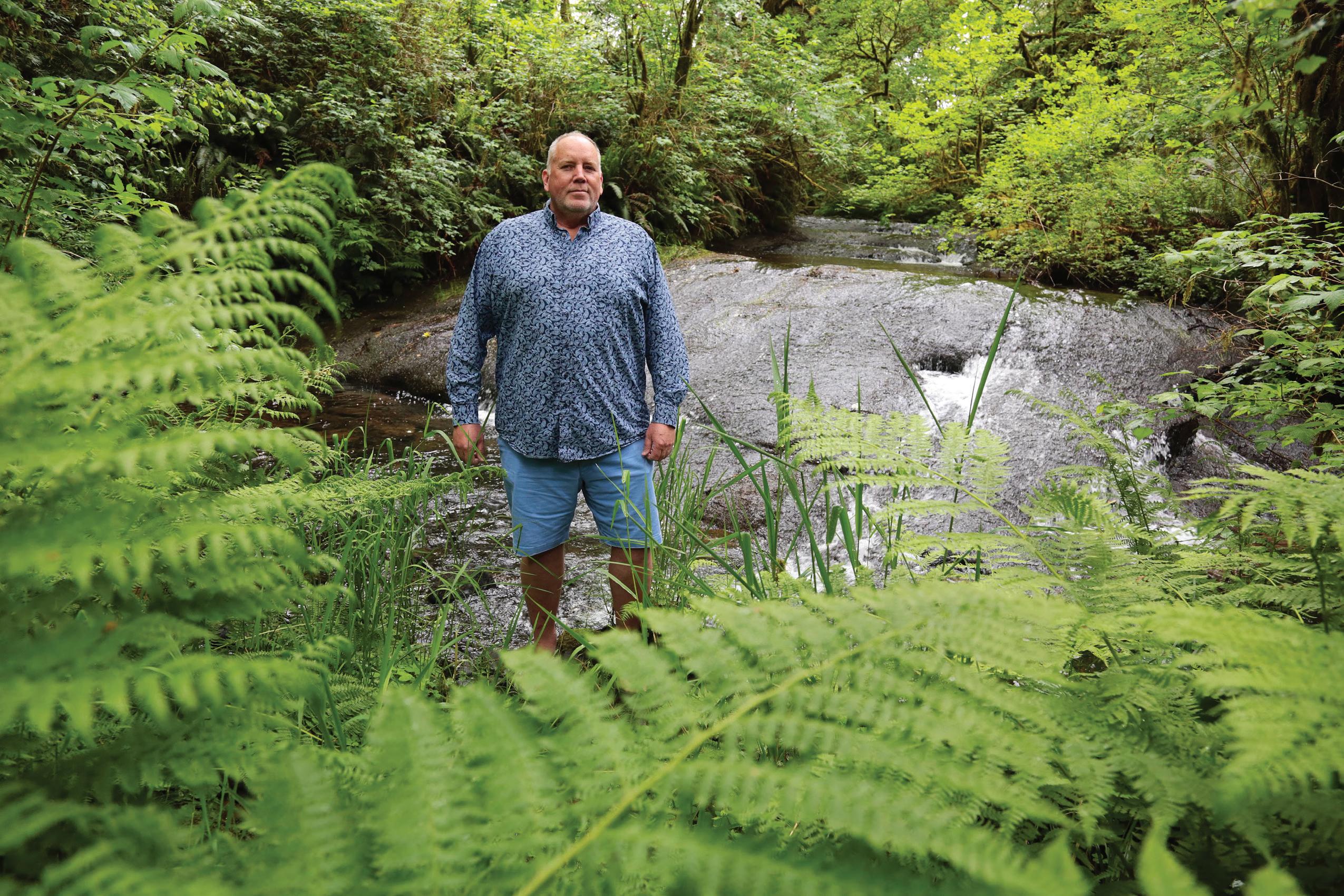
There is trauma there, buried in the ground, filling the recesses of the hard, volcanic rock.
Indigenous man “secreted” in a white woman’s home, according to Whaley. Tribal historians say their ancestors suffered violence both casual and organized, by both local militias and the U.S. Army.
“Pretty much the whole philosophy was to exterminate the Indians,” Archuleta said. “It was something that was pretty extreme during that time.”
In 1853, many of the Rogue River peoples gathered at Table Rocks to sign a treaty with the U.S. government in which they agreed to cede the lands in exchange for a permanent reservation, where they might be safe. Violence from militias continued during the treaty negotiations, an attempt to derail the process, tribal historians said. After signing the treaty, the people were removed to a temporary reservation at Table Rocks, where hardships continued.
Being forced to remain in one location kept the Rogue River peoples from their traditionally mobile practices of gathering, hunting and creating seasonal homes, resulting in starvation in addition to disease and continued attacks, according to historians. Those who left the reservation were often hunted down and killed by local militias.
The situation came to a head in 1855, when the deaths of two packers were blamed on Indigenous men. A white militia seeking to avenge the deaths left under the cover of darkness to the
Table Rock Reservation, where they killed about 25 people sleeping by the banks of the river, according to historical accounts. As they left, the militiamen killed another 50 to 80 Indigenous people in the area, most of whom were women and children.
The violence was particularly brutal. One witness recalled seeing two elderly women who were bashed to death with clubs and a child who was “taken by the heels and its brains dashed out against a tree.” According to Whaley, one attacker later said that while the extermination made him feel bad, “the understanding was that [the Indians] were all to be killed. So we did that work.”
In response to the attacks, a group of Indigenous leaders retaliated with raids on homesteads and settlements. In less than a year, roughly 250 Indigenous people were killed, along with some 50 non-Indigenous soldiers and 44 civilians, according to historical records.
Tribal members have been holding those horrific memories for generations.
“We have these historical legal traumas as well as physical and emotional and spiritual traumas,” which metastasized into issues like substance abuse and domestic violence, Kentta said. “We often hear about elders who don’t want to be hugged.”
Kentta’s great-grandfather was 7 or 8 years old when his people were removed from their homelands. After the boy’s father was killed, his mother left him with his paternal grandparents while she left to find her family. She never returned. The
boy left southwest Oregon as an orphan.
In February 1856, amid the fighting, U.S. soldiers led by Bureau of Indian Affairs agent George Ambrose moved 325 people by foot from the Table Rocks Reservation to a place that would become the Grand Ronde Reservation, 263 miles away. The 33-day journey went over mountains and along rivers, north through the Willamette Valley, roughly following the future Interstate 5 corridor, and up into the Coast Range.
Aside from the rugged environment, winter weather and generally poor conditions, the captive travelers also faced the constant threat of violence from militiamen stalking the group. Ambrose, who apprehended one man, eventually dissuaded militias from murdering members of the group, though casualties still mounted. According to Ambrose’s journal, the journey saw eight deaths among the captives – as well as eight births.
The Rogue River people who chose to stay and fight against removal held out until that summer, eventually surrendering after brutal losses. The surviving holdouts were taken to both the Grand Ronde and Siletz/Coast reservations, according to tribal historians.
Despite generations of oppression and the attempted genocide of a people, leaders in the Grand Ronde and Siletz tribes said they prefer a frame of resilience.
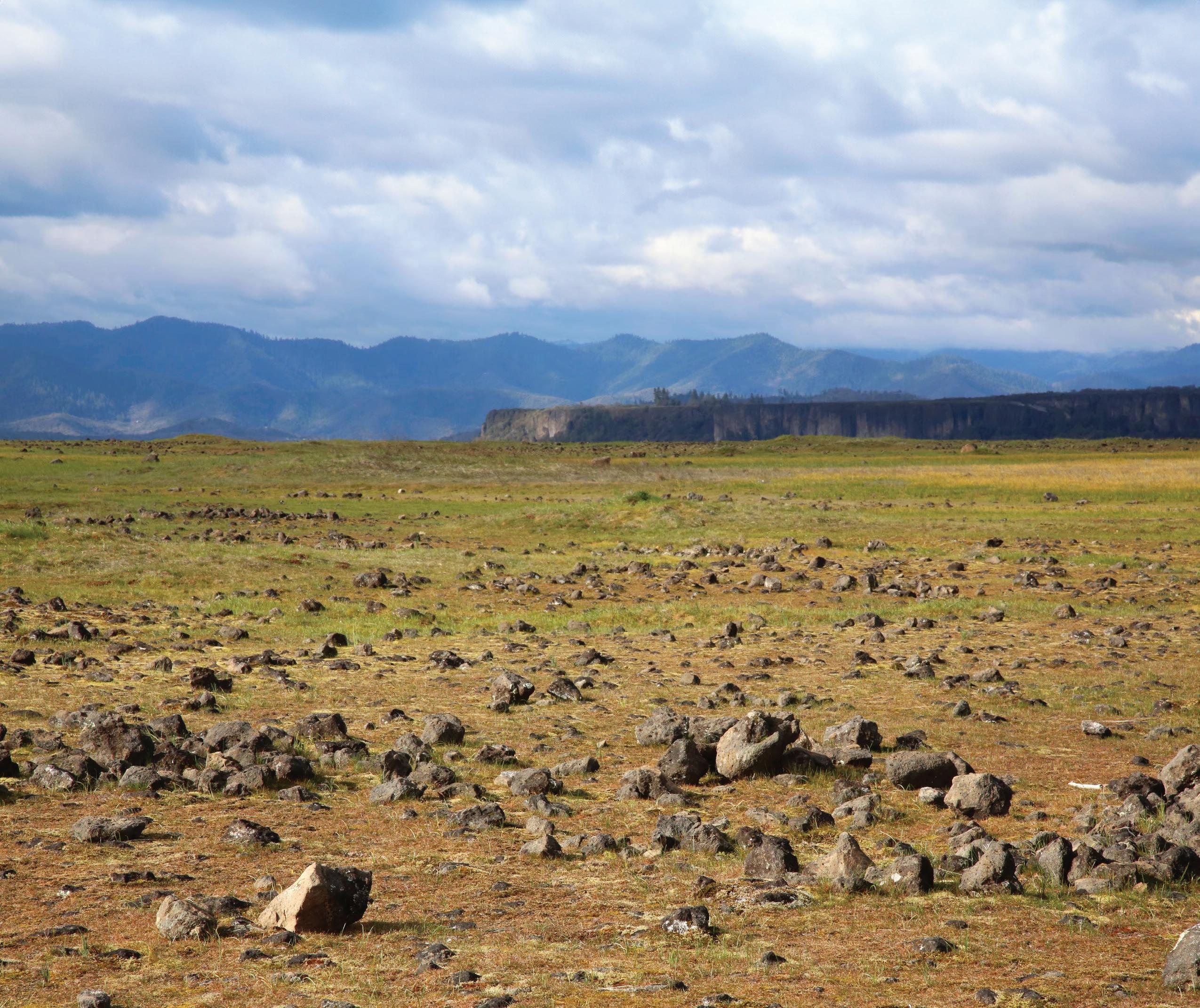
“There’s pride in the resilience of our ancestors,” Kentta said. “And some of it’s probably a stroke of luck that they didn’t get swept away.”
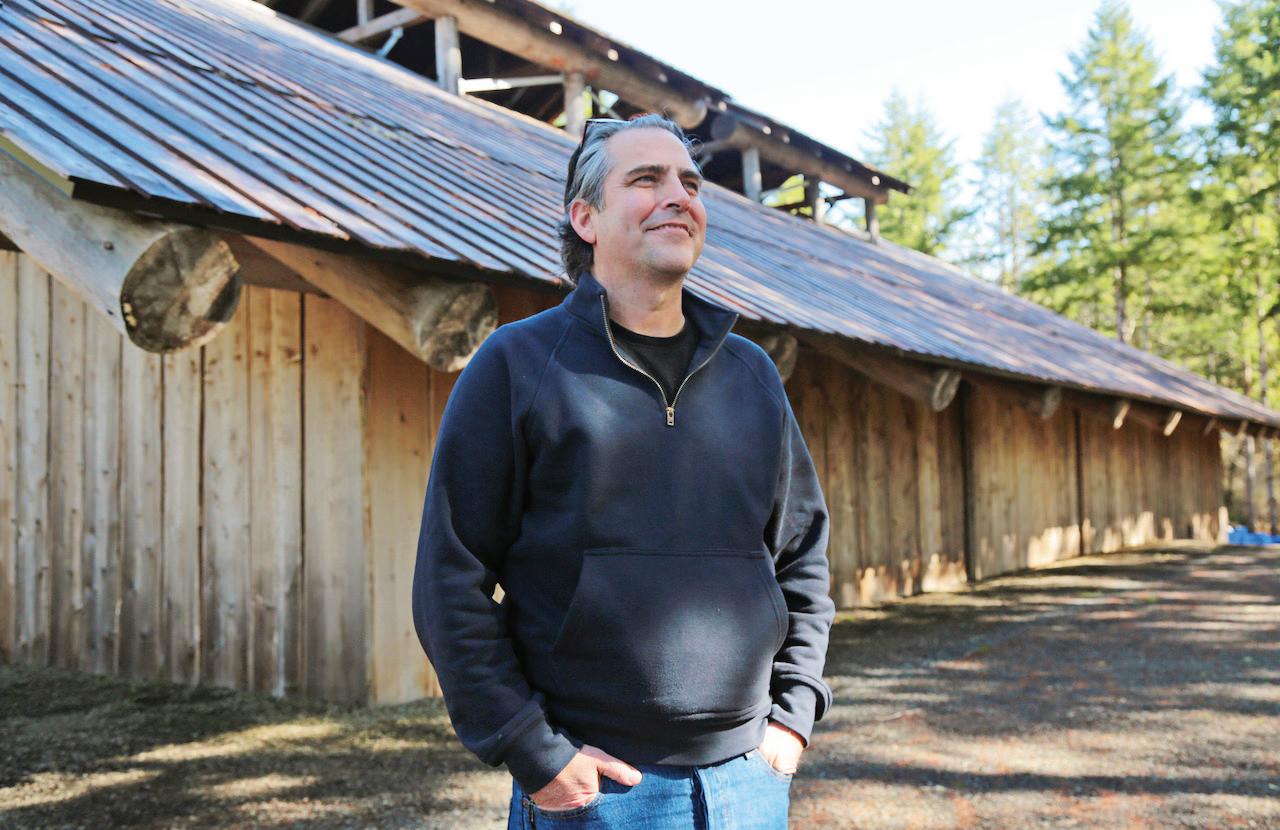
Travis
and Cultural Center
Ronde, stands outside a plankhouse named achaf-hammi.
Only in the past few decades have the tribes directly faced the past, seeking healing through conversation, support and returning to places of tragedy.
In the Grand Ronde Community, just a mile down the road from the tribe’s Spirit Mountain Casino, is a quiet place: the Uyxat Powwow Grounds, home to an outdoor arena lined with turf and a large ceremonial plankhouse named achaf-hammi.
Outside the plankhouse is a tall gray pole carved from a single western redcedar tree, marking this place as the end of the Rogue River Trail of Tears.
Travis Stewart, director of the tribe’s Chachalu Museum and Cultural Center, created the pole with a carving group for the plankhouse’s dedication in 2010. Standing at the base of the roughly 26-foot pole, he pointed out the headman at the top and coyote running down either side. The length of the pole is decorated with five tiers of faces representing five treaties signed by the tribe, he said, each face crying a stream of tears.
Those tears are not just from grief, Stewart explained, “they’re bringing their generational knowledge to this place and it’s coming out into the ground here.”
Traditional practices like carving and basket weaving, as well as harvesting plants for food and medicine, are now representations of the resiliency of Indigenous people throughout generations of hardship, Stewart said. The pole, the plankhouse, and events like Acorn Camp and Camas Camp are proof that this generational knowledge still exists.
“There was a lot of effort and sacrifice on behalf of those old people that made tough decisions ultimately in order to preserve that (knowledge),” Stewart said. “It’s a responsibility of ours to continue that.”
After the removal from southwest Oregon, the Grand Ronde and Siletz reservations became home to more Indigenous survivors, people from neighboring lands who spoke different languages, ate different food and practiced their own customs. At first, most people kept to their own (going so far as to organize themselves geographically), according to tribal historians, but as the U.S. Government shrank the reservations – Siletz from 1.1 million acres to nearly 17,000 today, Grand Ronde from 61,000 acres to 11,500 today – the people came together, creating new tribal communities.
“We’ve made our footprint here,” said Chris Mercier, vice chair of the Grand Ronde tribal council. “It wasn’t under the best circumstances that the tribal people were ushered up here, but I like the fact that we’ve established this community, one that’s been existing for over 150 years now.”
Of the 5,700 enrolled members of the Grand Ronde tribe, only about 1,200 today live in or around Grand Ronde, Mercier said. But those who do enjoy a tight-knit community, where the past, present and future of the tribe seem to collide at every turn.
For several generations after removal, people didn’t want to directly confront the traumas of the past, tribal leaders said. That was in large part due to ongoing struggles, including being forced to send their children to boarding schools, which were rampant with abuse, and the 1954 termination of western Oregon tribes, during which the government severed all federal support.
Only in the past few decades have the tribes directly faced the past, they said, seeking healing through conversation, support and returning to places of tragedy.
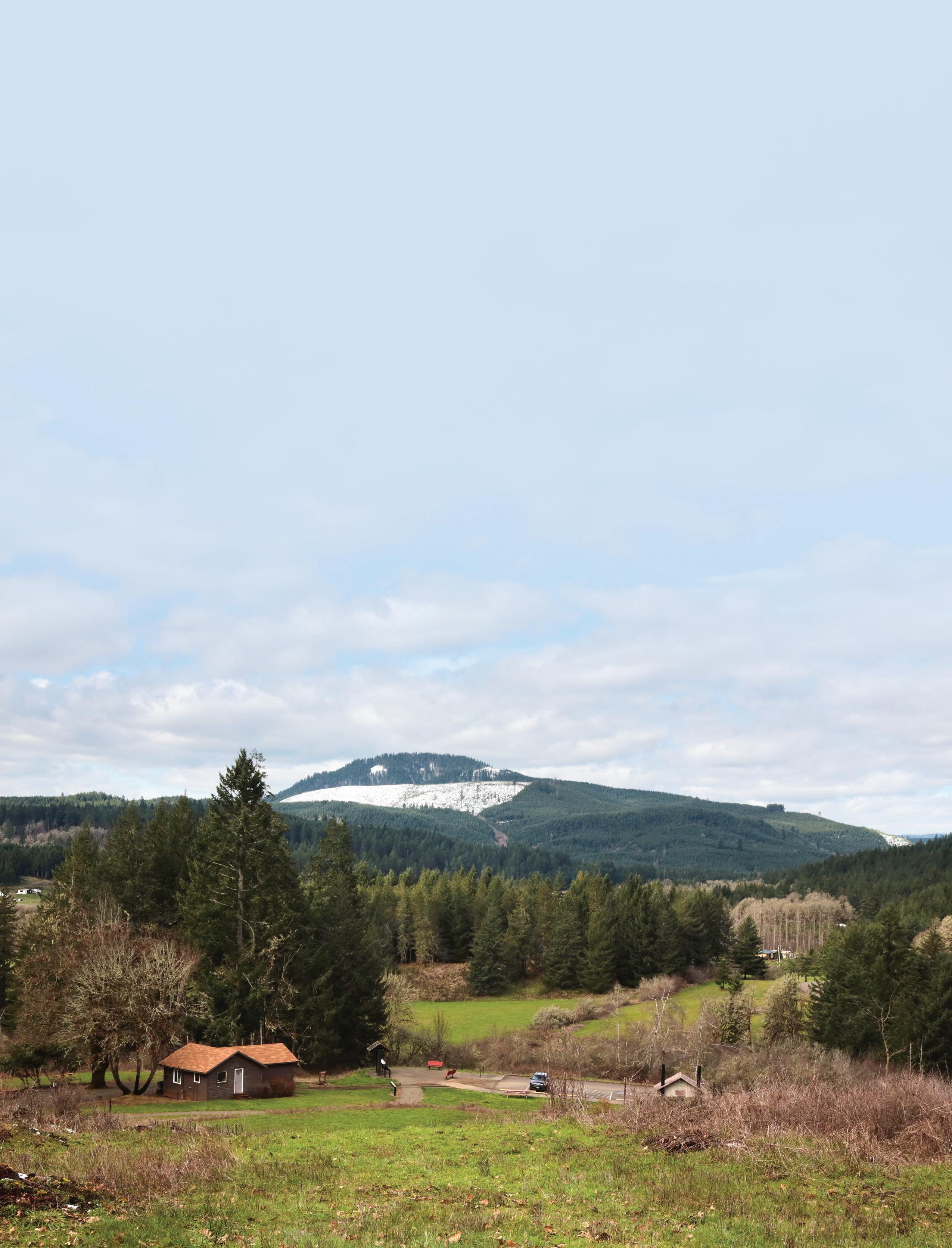
In the mid 1990s, the Siletz tribe started Run to the Rogue, in which tribal members run and walk their way down the coastline, then up the Rogue River to a place called Oak Flat, about 50 miles from Table Rocks, where in 1856 several bands of the tribe’s ancestors surrendered to the U.S. Army.
Buddy Lane, cultural resources manager for the tribe, has been organizing the event since 2012. He said runners of all abilities participate to different degrees. The tribe’s youngest members take the first mile in Siletz, and the elders take the final mile to Oak Flat. The strongest runners take the hardest miles along U.S. 101 at Cape Perpetua, a stretch Lane has done before.
“The trek is a lot easier than it was for our ancestors,” Lane said.
Many tribal members follow runners along the route, supporting their effort and finding ways to reconnect with their roots, he said. Some pay visits to the lands where their families once lived, or gather in parks, staying up late into the night as runners come and go.
“It’s an emotionally charged event,” Lane said. “We’re not celebrating something, but we’re remembering things and making sure those folks with stories are not forgotten.”
The relay, along with the Acorn Camp and Camas Camp, represents a new generation of tribal members who are actively connecting with their past through new experiences in the present, they said. The fact that these homecoming events all include a return trip back home – to Siletz, Grand Ronde and other places – underlines a complex question: What is “home” to a displaced people?
For Kentta, who has lived his whole life in Siletz and whose ancestors are from the Applegate Valley as well as Finland, southwest Oregon is like a home away from home.
“Whenever I’m in the Rogue Valley it’s kind of an emotional feeling of like a connection, even though I didn’t grow up there,” he said. “It’s an ancestral home rather than my current home.”
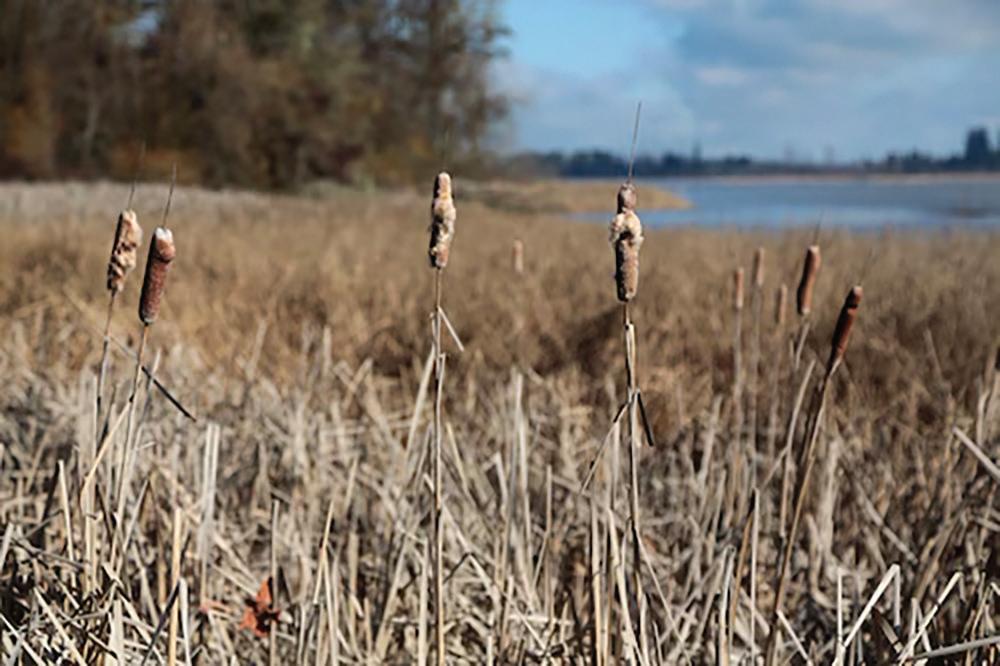
Archuleta grew up primarily in east Portland and traces his ancestry to the Willamette Tumwater, Clackamas Chinook, Cascades Chinook, Santiam Kalapooia, Shasta and Rogue River peoples. He has family ties to the Warm Springs, Yakama, Siletz and Klamath tribes. “Pretty much all of western Oregon” is home, he said.
“It’s really each person, each family’s perspective of how they see it,” he said.
While many other places may be home, for these sister tribes, there’s still something special about the land in southwest Oregon. Table Rocks has always been an important place,
a site of harvest and ritual, as well as the setting of creation stories, tribal historians said. Today, for non-Indigenous people, Lower Table Rock and Upper Table Rock are primarily places for recreation and conservation, managed by the Bureau of Land Management and environmental nonprofit The Nature Conservancy.
The area is home to more than 340 species of plants and 70 animals, including the tiny dwarf-wooly meadowfoam wildflower, which grows nowhere else in the world, as well as a threatened species of fairy shrimp, which hatches in vernal pools that form in the rocky soil every winter.
For the descendants of the Takelma, Shastan and Athabaskan people, it is also once again becoming a place to build community, while communing with a landscape that holds a rich and complicated history.
“Some of these activities that we’re doing is to bring back healing, bring back families together, and to connect to the landscape, and to continue that stewardship and responsibility to the land,” Archuleta said. “Just being able to fish in a place where your ancestor fished or gathered … it’s restoring what’s always been there, and what’s always been in our hearts and minds.”







Beach Creek is a neotraditional neighborhood of 55 smartly designed view homes focused on e cient living, wise resource use, and a low carbon footprint. For more information or to schedule a tour, please visit www.Kda-homes.com or call us at 541-944-7730.

JON HAMILTON
Aflexible film bristling with tiny sensors could make surgery safer for patients with a brain tumor or severe epilepsy.
The experimental film, which looks like Saran wrap, rests on the brain’s surface and detects the electrical activity of nerve cells below. It’s designed to help surgeons remove diseased tissue while preserving important functions like language and memory.
“This will enable us to do a better job,” says Dr. Ahmed Raslan, a neurosurgeon at Oregon Health and Science University who helped develop the film.
The technology is similar in concept to sensor grids already used in brain surgery. But the resolution is 100 times higher, says Shadi Dayeh, an engineer at the University of California, San Diego, who is leading the development effort.
“Imagine that you’re looking on a clear night at the moon,” Dayeh says, “then imagine [looking through] a telescope.”
In addition to aiding surgery, the film should offer researchers a much clearer view of the neural activity responsible for functions including movement, speech, sensation, and even thought.
“We have these complex circuits in our brains,” says John Ngai, who directs the BRAIN Initiative at the National Institutes of Health, which has funded much of the film’s development. “This will give us a better understanding of how they work.”
The film is intended to improve a process called functional brain mapping, which is often used when a person needs surgery to remove a brain tumor or tissue causing severe epileptic seizures.
During an operation, surgeons place a grid of sensors on the surface of an awake patient’s brain, taking care not to tear the delicate film. Then they ask the patient to do tasks, like counting or moving a finger.
Some of the tasks may be specific to a particular patient.
“If somebody is a mathematician, we’ll give them a math formula,” Raslan says. “If somebody is a painter, we’ll give them what’s called a visual cognition task.”
The sensors show which brain areas become active during each activity. But the borders of these areas tend to be irregular, Raslan says.
“It’s like a shoreline,” he says, “it zigzags and it curves around.”
The accuracy of a brain map depends on the number of sensors used.
“The clinical grid we use now uses one point of recording every one centimeter,” Raslan says. “The new grid uses at least 100 points.”
That’s possible because each sensor on the new grid is “a fraction of the diameter of the human hair,” Dayeh says. And the grid
itself is bonded to a plastic film so thin and flexible that it conforms to every contour of the brain’s surface.
The device works well in animals. And in May, the FDA approved it for testing in people.
Dayeh and Raslan, who both hold a financial interest in the device, say the team is already working on a wireless version that could be implanted for up to 30 days. That would allow people with severe epilepsy to be monitored for seizures at home instead of in the hospital.
Ultimately, the researchers hope to use this diagnostic tool as a brain-computer interface for people who are unable to communicate or move.
That would allow them to “transduce their thoughts into actions,” Dayeh says.
Scientists have already created this sort of brain computer interface using sensors implanted deep in the brain. But a grid on the brain’s surface would be safer, and could potentially detect the activity of many more neurons.
Daye’s research is part of the federal BRAIN Initiative, which was launched a decade ago to develop tools that would reveal the inner workings of the human brain.
The new grid is one of the tools, Ngai says. But it also promises to improve care for people with brain disorders.
“Ultimately, the goal was to develop better ways of treating human beings,” Ngai says, “and I think this gives us a pretty big stride toward that goal.
Future strides may come more slowly. This year, Congress cut BRAIN Initiative funding by about 40 percent.
Even so, Ngai says, the new sensor grid and its wireless counterpart show just how far the field has come.
A decade ago, Ngai says, some of the nation’s top electrical engineers and computer scientists said there was no way devices like these would work.
“You look now,” he says, “and it’s being done.”

Jon Hamilton is a correspondent for NPR’s Science Desk. Currently he focuses on neuroscience and health risks.


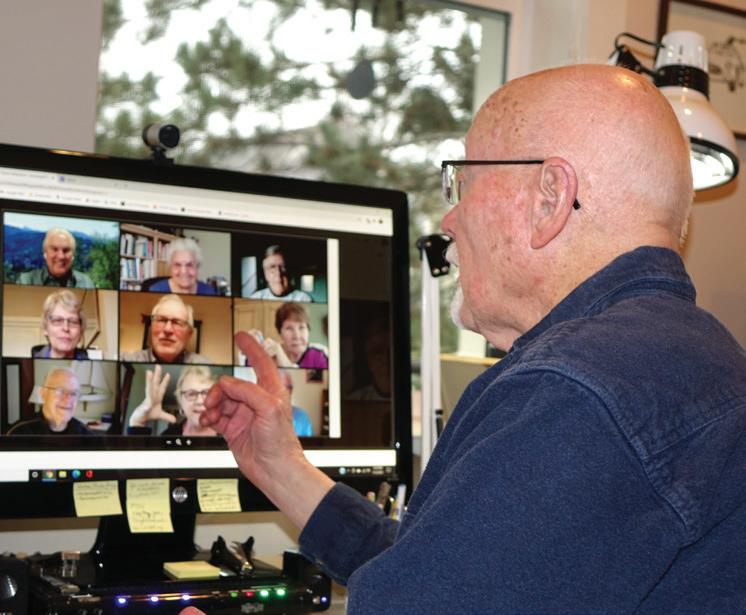
• Hundreds of classes, take all you want
• Social events, discussion groups, activities
• All-inclusive annual member fee of $150
• Visit dozens of exhibits from OLLI faculty, SOU, and community partners
• Preview 100+ OLLI fall courses and activities
• Enjoy free refreshments and enter to win valuable door prizes


ANNA KING
On a warm day in Centralia, Washington, south of Olympia, Alan Woods is standing surrounded by his 90 million bees.
“So, we’re in the middle of the bee field,” he said. “You look around, and you can see bees everywhere.”
A halo of bees buzzes around his head; he’s not wearing a protective veil.
Woods, who heads the Washington State Beekeepers Association, is what’s called a sideliner beekeeper, or a small operator. It can be a tough business. Woods said beekeepers lose about 30 percent of their hives per year now, and he often comforts beekeepers who’ve lost hives. He’s also a Christian pastor, maybe even a bee-pastor.
“I talk to a lot of people about God and bees at the same time,” Woods said with a chuckle.
Commercial beekeepers around the United States rent more than 2 million hives to pollinate almond crops in California. Hundreds of thousands of those hives are trucked from the greater Northwest.
However, there’s a problem this year. The pandemic, international shipping problems and over-planting have led to a glut of nuts in California, and almond growers there are in bad economic shape. Many of them are reducing their top expenses –like bees. That’s an issue for the beekeepers of the Northwest who rely on the income – and for the bees themselves.
Brandon Hopkins, a Washington State University honeybee researcher, keeps a close eye on the industry.
Hopkins said that after winter, bees wake up weak with diminished numbers in each colony. Pollinating almonds nourishes them with an abundant flow of nectar and pollen. He said the bees that are sent to California return home stronger and often double their colony numbers, splitting into new colonies.
Hopkins said this year, fewer colonies went to California. Some almond orchardists couldn’t afford the insects; others tried to scrape by with fewer bees than normal.
“If a half million colonies don’t go to almonds, then you have a half million colonies that sort of miss that really early spring buildup,” Hopkins said. “And so you have … fewer colonies from which you can do those early spring splits and things like that.”
He said those half million colonies mean, ultimately, a million colonies missing in the commercial bee ecosystem – that’s a $100 million hit to the beekeeping industry, and that’s not good news for fruit growers in the Northwest.
“I think what’s not so well known is how much the almond industry has really supported all the other industries that depend on honeybees for pollination,” Hopkins said. That includes Washington and Oregon apples, cherries and vegetable crops.

Meanwhile, commercial beekeepers have to keep an eye on their economic health. This year, Bud Wilhelm, who runs a large commercial beekeeping operation in Royal City, Washington, didn’t bring all of his 8,000 colonies to California, the way he usually would. It’s expensive and a big risk — shipping costs, feed for the bees, hotels for his workers.
“It was wise on our part to hold back some hives,” Wilhelm said. He wasn’t sure that he would get paid. “Especially, as some of these individuals I thought would pay, who are in a strong cash position, and who know me personally, you know, they are struggling to find the money to get us paid for those services.”
Wilhelm said bees are a sensor of things across the wider agricultural ecosystem. Many in ag are struggling now, he said. For the first time in his 15 years of beekeeping business, Wilhelm is seeing growers needing payment plans to cover his pollination services. He said farmers are tough.
“Even through all that strength and that hope and faith that these farmers have, they get to a point where they just financially can’t do it,” he said.
Wilhelm said for almonds and bees, he hopes for a brighter day.

Anna King calls Richland, Washington home and loves unearthing great stories about people in the Northwest. She reports for the Northwest News Network from a studio at Washington State University, Tri-Cities. She covers the Mid-Columbia region, from nuclear reactors to Mexican rodeos.

Telegraph Quartet
Friday, September 20 v 7:30pm
Quartetto di Cremona
Saturday, October 26 v 3pm

Chamber Music Society of Lincoln Center Winds & Piano
Friday, November 15 v 7:30pm

Israeli Chamber Project
Wednesday, December 4 v 7:30pm
Isidore Quartet
Wednesday, January 8 v 7:30pm
Ulysses Quartet
Friday, January 24 v 7:30pm
AGAVE with Reginald Mobley, countertenor
Sunday, February 9 v 3pm
by request: tenThing
By Request: Underwritten by Dr. Margaret R. Evans & Anonymous
Wednesday, February 26 v 7:30pm

Marmen Quartet
Saturday, March 8 v 3pm

Leonkoro Quartet
Friday, March 21 v 7:30pm
Trio Zimbalist
Saturday, April 12 v 3pm


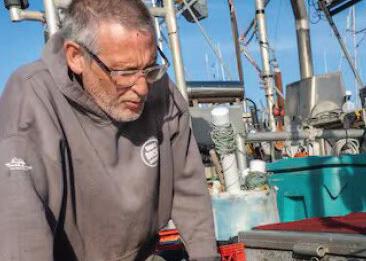
ALEJANDRO FIGUEROA
The coastal seafood butchery program also serves a broader economic purpose: to bolster the seafood workforce as industry groups look to keep more Oregon-caught fish local.
Patrick Clarke is outside, setting up a big pot of broth with Cajun spices over a propane flame. He’s already got a grill running and has set out the corn, potatoes, sausage and pink shrimp.
He leans down to a chest cooler filled with ice and pulls out a live Dungeness crab.
“This is the money maker right here on the Oregon coast,” he says. “The crab fishery is probably the most valuable fishery that we have in Oregon. It’s a billion-dollar industry. And a lot of it comes straight into Newport right down the road here.”
Clarke is the culinary director at Siletz Valley School — a K-12 charter school serving the Siletz Indian Reservation about a 20-minute drive outside Newport — and teaches a handful of cooking courses there. His school is one of six coastal high schools participating in a pilot seafood butchery program that launched in April with the intent to teach students how to clean and cut all sorts of fish and crustaceans found on the Oregon coast. They also learn how to cook seafood, and, perhaps more significantly, they learn about its relationship to communities up and down the coast.
Clarke, a nearly 20-year veteran of the restaurant industry, said filleting is a dying art around the coast and much of the Pacific Northwest.
“You could run into a bunch of these high-end restaurants, I bet you six out of 10, if you ask one of their head chefs to fillet a salmon and pin bone it, he would get very nervous at that point,” he says. “Because they don’t do it anymore.”
The coastal seafood butchery program also serves a broader economic purpose: to bolster the seafood workforce as industry groups look to keep more Oregon-caught fish local. But first, the hands-on part. On the menu for the day: gumbo, with crab boil and shrimp cakes and a side of lamb chops.
Clarke puts two students in charge of grilling the sausages and the lamb chops. Another small group joins him to split the crabs and boil the legs. They begin doing it carefully by hand and discarding the guts into a trash bin.
Dean Smith, a junior, says it was easy to get the hang of it.
“I pretty much understand it, all I needed was to see it one time,” he says. “I just wanted to take this class so I could learn how to cook for myself when I’m older.”
Another student, Landynn Larson, a sophomore, points out an easier way to do it. He grabs one of the crabs firmly by the legs and with one single motion jabs the head of the crab against the edge of a metal table, cleanly separating the head from the legs.
“There you go, you take his whole head off. That was pretty good. I’ve never done it that way,” Clarke says, praising Larson.
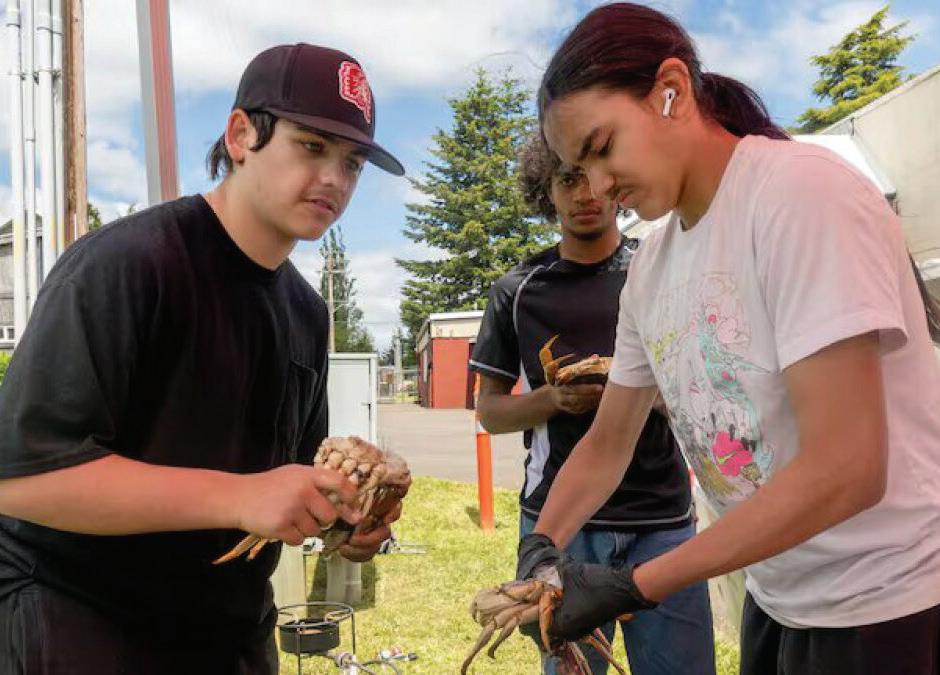
Larson says he learned that from his grandfather, who’s taught him how to clean and cut fish and to hunt. Larson plans to go to college to study architecture, but can see himself working at the docks and restaurants filleting fish.
“I can get a degree for that and work around here cutting up fish and cooking and all that for boats and for people, businesses,” Larson says. “That’d be a cool job to have, kind of a back up plan.”
Clarke says it’s hard to come by skilled filleters. That’s partly because it’s more cost-efficient for restaurants to order portioned fish rather than paying someone to clean and cut it. Plus many of the seafood processing plants along the coast have shut down or consolidated over the years. Most of them are now concentrated around Newport and Astoria in the north and Charleston on the southern coast.
The Oregon coastline spans over 300 miles, and it’s bountiful with fish like lingcod, rockfish, Chinook salmon and Dungeness crabs.
But 90% of the seafood sold and consumed on the Oregon coast is imported from domestic or international markets while most of what’s caught is exported. Yet locally, there’s a growing demand for more fish and crab caught on the Oregon coast, according to Maggie Michaels, the lead for the High School Seafood Butchery program for the Oregon Ocean Cluster Initiative — a group supporting efforts to keep more local seafood.
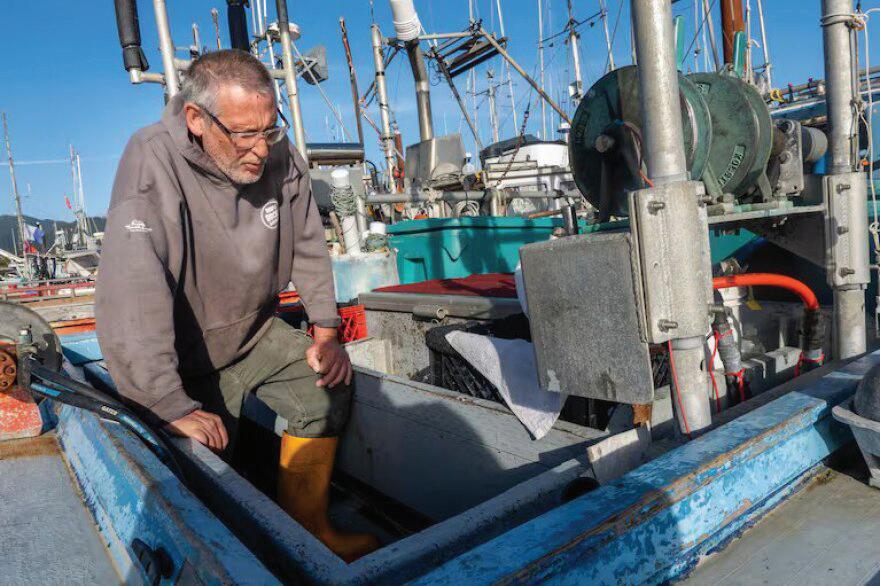
Kelly Barnett cleans and organizes equipment in his trawler boat after a day of fishing off the coast in Garibaldi, Ore., May 23, 2024. Barnett is a fishmonger on the Oregon coast that catches, fillets and sell fish to local customers and visitors.
“Schools want more of it, institutions want more of it. People going to the grocery stores want more of it,” Michaels says.
Oregon’s “blue economy” — the sustainable use of ocean resources for economic growth — is driven by its commercial fishing industry. Much of it is also supported by tourism. According to the Oregon Ocean Cluster Initiative’s latest figures, visitors to the Oregon coast spend about $800 million on seafood and other food services per year, though much of that money isn’t spent on locally caught seafood.
Michaels says the group is looking to change that, and as more people ask where their seafood is coming from, communities need a workforce that matches that pent-up demand.
“We’re going to need more people to fillet because across the continuum of the seafood industry and seafaring industry we have a graying out,” Michaels says. “The folks who have these skills are getting older.”
Kelly “the Blade” Barnett knows just how valuable those skills are.
“You need somebody who can get all the meat off the fish because you don’t wanna waste it. That fish has sacrificed himself for us to eat. And to waste it is a crime,” he says.
Barnett is a fishmonger, he also catches his own fish and sells it at his market, the Spot, at the Port of Garibaldi.
After a day of fishing, he’s getting caught up on cleaning and smoking a batch of salmon ahead of Memorial Day weekend. He’s been filleting fish for nearly four decades. As for his nickname, he says there was a charter boat operator several years ago that used to put on a P.T. Barnum voice to introduce him whenever he showed up.
“Ladies and gentlemen, boys and girls, children of all ages, Siggi-G charters proudly presents Kelly ‘the Blade,’” he says. “And that name stuck.”
He’s seen things change.
“There was a fish plant at the end of the road here. And there were 12 to 20 skilled filleters there that worked full-time. And they would lend their talents to cutting the sports people’s fish,” he says. “And now there’s maybe two or three of us that do it commercially [in Garibaldi].”
He remembers when the filleters in training at the nowclosed plants used to practice on the fish that were too small to be commercially viable.
“Then we would take that — you know, 10 to 12 of us — up to the bar and give it to the bartender,” he says. “They would cook it up in their fish fryer and serve it to everybody in the bar. And so everybody enjoyed.”
He says what’s lost when the talent disappears from the coast is a sense of community and the ability to prepare and share a meal with someone. But he doesn’t let that keep him down. He’s helped train some of the high schoolers in the butchery program and sees similar efforts as a continuation of his community.
“They genuinely want that knowledge,” he says. “They made me feel really good that I had a skill to share that not everybody’s gonna get, but once you get it, you’ve got it for life.”
Back at Siletz, students are done boiling the crab legs and grilling the lamb chops, and are lining up for a plate. Students and teachers from other classes are queuing up for a bite too.
Some distance away, Clarke looks back and says seeing his students sharing the food they’ve made is one of the moments he most looks forward to.
“I don’t know how important, just that scene right there is,” he says.
He knows not all high schoolers will want to go into seafood. But at least they’ve done it and they learned something.
“[Cooking] is a gigantic part of life. It’s relaxing. It’s fun to do. You can impress dates with it,” he says. ”You create social dynamics by just sitting at the dinner table and having everybody sit down and share a meal.”
He knows how uncertain life can be as a teenager, and maybe, he says, he’ll run into an old face down the line.
“I hope I have students that come back and maybe they’ll get a James Beard nomination,” he says. “Or maybe I’ll just see them 10 years down the road and they’ll be like, ‘Pat, I’m cooking, I’m a chef now,’ and I’ll be like, ‘What? No kidding.’”
Copyright 2024 Oregon Public Broadcasting

Alejandro Figueroa is a reporter and producer covering food production and agriculture through a climate change lens for OPB.

If you’d asked my children when they were growing up, “How many are in your family?” They’d have said, “Five: a Mom, a Dad, two daughters and the Rogue River.”
And they’d have been right. For fifty years I have had the privilege of living on the banks of the Rogue. This ancient river has served at times as sibling, friend, nurturer, challenger and, always, as teacher. Two hundred times I have been a witness, watching and listening as the season changes.
Autumn announces its arrival when the vine maple turns a gaudy shade of almost fuchsia, its long tendrils graceful, floating on invisible breezes.
Then---it’s the same every year---my windows wide open to feel the welcome downturn in temperature, I hear a singular sound. It’s the briefest of splashes, quick, over in a second. It’s a salmon using her tail to dig a hole in the gravel, so she can lay her eggs.
I call my family to tell them she has come home.
The salmon are coming back! I grab binoculars and run outside to see the arrival of the first of the spawners. This fish spends her youth in the river, where she survives the fisherman’s hook. Then she heads to the salt water of the ocean for a few years, where she survives the orcas, seals and sea lions. Returning home, she’s old, her body scarred and mottled from her long journey. She has traveled an amazing hundred miles from the sea to lay her eggs close to where she was born. I’m a mother, too. I think I understand her perseverance. I’m old now, too, I think I understand her sacrifice.
I stare at her unblinking eyes. Does she see me watching her? Is she looking back at me?
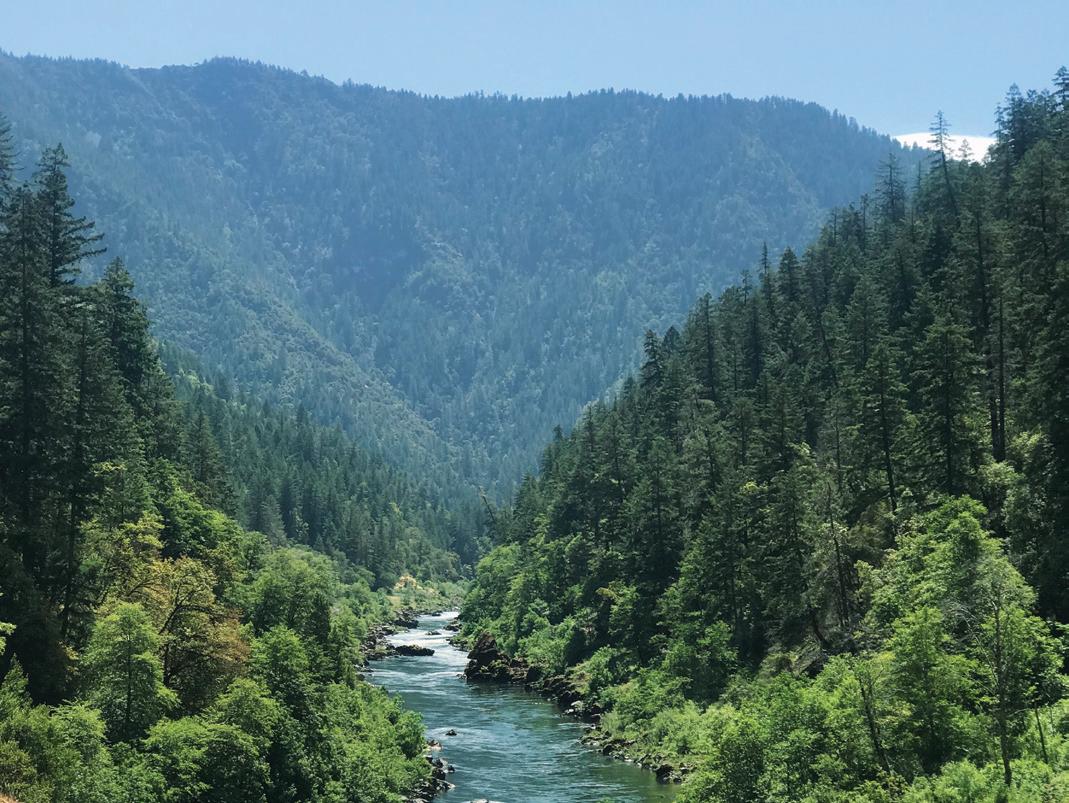
She has done all she can, and so her life ends.
In winter, with the distraction of the vivid leaves fallen from the trees, and many of the birds away---migrated to warmer climes---the river comes fully into view. Besides bare branches, it’s the only thing to see outside my window.
Wider and wilder than in other seasons, the river roars with power, its sound deafening, drowning conversation. Its level going up and up, closer and closer. The river swallows rain, devours delicate snowflakes. Grey in the daylight, black at night. I can only surrender to its threatening presence. The Rogue, true to its name, promises no fairness.
Spring brings the play of otters, a quick glimpse of beavers, and the riot of color like the vibrant hues of newborn leaves and the primary colors of wildflowers that compete with the river for attention. My eyes don’t know where to look first. But, infused with mountain snow melt that clarifies its riffles and rapids, the river is at its most playful in spring, its sound a child’s song.
Fox dart across the meadow, turkeys peck and strut, and deer give birth under the big pine, then drink from the river and, sometimes, swim across to the other side.
I know summer is here when the oak trees, at last, unfurl their baby leaves. The fragile forms are almost translucent, their color a holy green, hinting at some newer world.
These dry months of summer mean the river’s depth is shallow, its voice hushed, allowing the squawking variety of ducks and the chirping, singing, trilling of birds to dominate with their rowdy cacophony.
Bejeweled by the sun, the river’s summer face is so bright it should come with a warning: “The surgeon general has determined that glimpsing this river may damage your eyesight. Do so at your own risk.” But glimpse I must, when my soul longs for light, as it almost always does. When I hope for insight, as I almost always do.
Summer nights, when the sun finally falls behind the Table Rocks, the river becomes a quiet mirror, reflecting light from stars that ceased to exist eons ago.
Always, the river abides.
There are no words to describe the joy of being a witness to this cycle, to notice how each season is the same and yet unique from any that has gone before.
But also, through my times of despair, the loss and tragedy that my life---that every human life---experiences, the Rogue River maintains its constancy. It flows, as it has for millennia, from its source high up near Crater Lake to its Pacific Ocean destination. Its rhythm changes with the seasons, its colors morph from blue to green to grey to black, but its path is lucid, its timeless purpose unchanged.
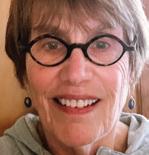








FM Transmitters provide extended regional service. (KSOR, 90.1FM is JPR’s strongest transmitter and provides coverage throughout the Rogue Valley.)
FM Translators provide low-powered local service.
Monday through Friday..
5:00am Morning Edition
8:00am First Concert
12:00pm Siskiyou Music Hall
2:00pm Performance Today
4:00pm All Things Considered
6:30pm The Daily
7:00pm Exploring Music
8:00pm State Farm Music Hall
Saturday..
5:00am Weekend Edition
8:00am First Concert
10:00am Metropolitan Opera
2:00pm Played in Oregon
3:00pm The Chamber Music Society of Lincoln Center
KSOR 90.1 FM ASHLAND
KSRG 88.3 FM ASHLAND
Big Bend 91.3 FM Brookings 101.7 FM Burney 90.9 FM Camas Valley 88.7 FM Canyonville 91.9 FM Cave Junction 89.5 FM
Chiloquin 91.7 FM
KSRS 91.5 FM ROSEBURG
KNYR 91.3 FM YREKA
KOOZ 94.1 FM
4:00pm All Things Considered
5:00pm New York Philharmonic
7:00pm State Farm Music Hall
Sunday..
5:00am Weekend Edition
9:00am Millennium of Music
10:00am Sunday Baroque
12:00pm American Landscapes
1:00pm Fiesta!
2:00pm Performance Today Weekend
4:00pm All Things Considered
5:00pm Chicago Symphony Orchestra
7:00pm State Farm Music Hall
MYRTLE POINT/COOS BAY
Coquille 88.1 FM Coos Bay 90.5 FM / 89.1 FM Etna / Ft. Jones 91.1 FM Gasquet 89.1 FM Gold Beach 91.5 FM
July 6 – Don Giovanni by Wolfgang Amadeus Mozart
July 13 – Das Rheingold by Richard Wagner
July 20 – Elektra by Richard Strauss
July 27 – Médée by Marc-Antoine Charpentier
August 3 – Damnation of Faust by Hector Berlioz
August 10 – Don Carlo by Giuseppe Verdi
August 17 – Rusalka by Antonin Dvorák
August 24 – Idomeneo by Wolfgang Amadeus Mozart
August 31 – Tosca by Giacomo Puccini
KZBY 90.5 FM
COOS BAY
KLMF 88.5 FM
KLAMATH FALLS
KNHT 102.5 FM RIO DELL/EUREKA
Grants Pass 101.5 FM Happy Camp 91.9 FM
Lakeview 89.5 FM
Langlois, Sixes 91.3 FM
LaPine/Beaver Marsh 89.1 FM






Monday through Friday..
5:00am Morning Edition
9:00am Open Air
3:00pm Today, Explained
3:30pm Marketplace
4:00pm All Things Considered
6:00pm World Café

8:00pm Folk Alley (M) Mountain Stage (Tu) American Routes (W) The Midnight Special (Th) Open Air Amplified (F)
10:00pm Turnstyles
3:00am World Cafe
Saturday..
5:00am Weekend Edition
9:00am Wait Wait...Don’t Tell Me! 10:00am Radiolab
1:00pm Mountain Stage
3:00pm Folk Alley
5:00pm All Things Considered
6:00pm American Rhythm
8:00pm The Retro Cocktail Hour
9:00pm The Retro Lounge
10:00pm Late Night Blues
12:00am Turnstyles
Sunday..
5:00am Weekend Edition
9:00am TED Radio Hour
10:00am This American Life
11:00am The Moth Radio Hour
12:00pm Jazz Sunday
2:00pm American Routes
4:00pm Sound Opinions
5:00pm All Things Considered
6:00pm The Folk Show
FM Transmitters provide extended regional service.
FM Translators provide low-powered local service.
KSMF 89.1 FM ASHLAND


KSBA 88.5 FM COOS BAY
KSKF 90.9 FM KLAMATH FALLS
11:00am Snap Judgement 12:00pm E-Town
KNCA 89.7 FM BURNEY/REDDING
KNSQ 88.1 FM MT. SHASTA
KVYA 91.5 FM CEDARVILLE/ SURPRISE VALLEY


9:00pm WoodSongs Old-Time Radio Hour
10:00pm The Midnight Special 12:00am Turnstyles
Callahan/Ft Jones 89.1 FM Cave Junction 90.9 FM
89.3 FM





KSJK AM 1230
TALENT
KAGI AM 930
GRANTS PASS
AM Transmitters provide extended regional service.
FM Transmitter
FM Translators provide low-powered local service.

KTBR AM 950 ROSEBURG
KRVM AM 1280 EUGENE
KSYC 103.9 FM YREKA
Monday through Friday
12:00am BBC World Service
7:00am 1A
9:00am The Jefferson Exchange
10:00am Here & Now
12:00pm BBC News Hour
1:00pm Today, Explained
1:30pm The Daily
2:00pm Think
3:00pm Fresh Air
4:00pm The World
5:00pm On Point
6:00pm 1A
7:00pm Fresh Air (repeat)
8:00pm The Jefferson Exchange (repeat of 9am broadcast)
9:00pm BBC World Service
Saturday..
12:00am BBC World Service
7:00am Inside Europe
8:00am Left, Right & Center
9:00am Freakonomics Radio
KHWA 102.3 FM MT. SHASTA/WEED
KJPR AM 1330
SHASTA LAKE CITY/ REDDING
KPMO AM 1300
MENDOCINO KNHM 91.5 FM BAYSIDE/EUREKA
10:00am Planet Money/How I Built This 11:00am Hidden Brain
12:00pm Living on Earth
1:00pm Science Friday
3:00pm To the Best of Our Knowledge 5:00pm Radiolab
6:00pm Selected Shorts
7:00pm BBC World Service
Sunday
12:00am BBC World Service
7:00am No Small Endeavor
8:00am On The Media
9:00am Throughline 10:00am Reveal
11:00am This American Life
12:00pm TED Radio Hour
1:00pm The New Yorker Radio Hour
2:00pm Fresh Air Weekend
3:00pm Milk Street Radio
4:00pm Travel with Rick Steves
5:00pm To the Best of Our Knowledge 7:00pm BBC World Service
Ashland/Medford 102.3 FM
Klamath Falls 90.5 FM / 91.9 FM
Grants Pass 97.9 FM
98.7 FM
As Oregon’s Summer Skies Become Increasingly Filled With Wildfire Smoke, Some Communities Will Have An Opportunity To See Just How Unhealthy Their Air Is.
April Ehrlich/OPB
The Oregon Department of Environmental Quality is launching a program that will give four communities air monitors for pollutants and identify potential solutions. The three-year pilot program, called Community Air Action Planning, can test the air for smoke particulates — whether from wood stoves or wildfires — as well as traffic pollution. They’ll measure meteorological data, like heat and wind direction, which could help regulators determine why pollution might gather in certain neighborhoods.
The program will work closely alongside community members to identify their air quality concerns, install monitors throughout the area, collect data, and compile it into a report. The report also will summarize narratives collected from residents, in part to find if there are specific areas that people avoid because of air pollution.
DEQ will select communities this summer based on a variety of socioeconomic, health and pollution indicators.
DEQ public engagement analyst Ryan Bellinson, who’s helping run the program, said it’s intended to empower communities and broaden DEQ’s work.
“DEQ will be supporting them in gaining agency and taking action for improving their air quality,” Bellinson said. “But they’ll also be helping us as a regulatory agency learn about how we can support overburdened communities in effective ways.”
Bellinson said he hopes to work with at least one community that’s heavily impacted by wildfire smoke, such as in Central or Southern Oregon. The program might also include a dense, urban community that’s particularly vulnerable to “black carbon,” which is soot from traffic and other fossil fuel pollution.
The three-year pilot program is funded by a $1 million federal grant, but Bellinson hopes to find additional funding to continue the program in future years.
Program staff will help community members identify where to install the monitors and how to get them serviced if they’re not working.
These monitors will likely collect data over a span of six months to a year, depending on what type of pollution community members are most concerned about. After that, the air program will help identify ways to mitigate pollution, like establishing clean-air shelters, distributing air filters, or finding ways to monitor other pollutants and toxins. Bellinson said the program has some money to help fund these solutions, and if that’s not enough, DEQ can help community members apply for grants or other funding sources.
“We want to work with the community so when they get the data at the end, they’ll be empowered to take action, whatever that might look like for them,” Bellinson said.
Three other agencies are partnering with DEQ on the program. Desert Research Institute, a Nevada-based nonprofit, will visualize the data collected from air monitors. The Portland-based nonprofit Neighbors For Clean Air will help DEQ staff build relationships with community members. Then, Portland State University will evaluate outcomes from the pilot program.
Copyright 2024 Oregon Public Broadcasting
Roman Battaglia/JPR News
The Britt Music and Arts Festival has struck a deal with Jackson County to purchase a historic building in Jacksonville. Once the sale is finalized, the festival has plans to convert the building into an office and performance space.
The $1.45 million dollar purchase would further cement the Britt Festival’s role as a major economic driver in Jacksonville, where the festival grounds are located.
The 10,000-square-foot U.S. Hotel was constructed in the late 1880s, and is currently rented out to an antiques business.
This iconic building would be home to the Britt Festival offices, which are currently located in Medford.
Britt Festival President Abby McKee said they’ve been looking to move their offices to Jacksonville for 35 years.
“Britt is a 501(c)(3) non-profit, and for us to amass support and funding to be able to purchase a new building, that’s a pretty major undertaking,” McKee said.
Jacksonville is also a tricky place to find a property like the one Britt staff were looking for, she said, because of the city’s many historic buildings and the lack of real estate to meet their needs.
McKee said the reason for their current Medford location is because many Britt patrons used to come from East Medford, and having the box office located closer made things easier before most tickets were sold online.
McKee said they’re planning on renovating the U.S. Hotel building to include a performance and education space upstairs.
“The ability to have a space that is our home, where we can welcome people in and have interactive opportunities, where people can be learning new skills or just experiencing the arts, that’s been a really exciting prospect for us,” McKee said.
It will take a few years to renovate the building, according to McKee. That includes things like seismic upgrades and installing an elevator.
Jackson County commissioners previously delayed a vote to sell the building to Somar Family Vineyards after the Britt Festival submitted a competing offer.
McKee said they’re currently in escrow while final inspections take place.
Roman Battaglia/JPR News
Ahousing affordability council with the state of Oregon approved an additional $12 million dollars to purchase new homes for a mobile home park that burned down in the 2020 Almeda Fire. The money will replace homes the state bought that were found to be defective.
Oregon Housing and Community Services originally purchased 140 modular homes from Nashua Builders in Boise, Idaho for $26 million. 118 of those were installed at Royal Oaks Mobil Manor in Phoenix.
But, after major construction defects were found a year ago, the state decided to entirely replace the homes.
On June 7, the state’s Housing Stability Council met to approve $12 million for the new homes, plus an additional $5 million in tax credits. That money will come from remaining state wildfire funds allocated after the 2020 Labor Day Fires.
OHCS Deputy Director Caleb Yant said they’re asking for this money before pursuing possible legal action against the Idaho manufacturer to keep the Royal Oaks redevelopment moving forward.
“It’s been noted that there aren’t court filings that have occurred and I want council members to know that that does not mean that we’re not actively pursuing accountability for not getting a product that we paid for,” he said.
Council Member Mary Li from the Multnomah Idea Lab said she had some concerns about the urgency with which the agency is moving forward with this funding request, especially when they haven’t addressed some of the other parts of the project, like the timeline for getting the units ready for move-in. The opening of Royal Oaks was originally slated for September 2023.
OHCS Executive Director Andrea Bell said that they’re working to push forward multiple pathways for this project at the same time.
“We are moving forward on the initial commitment made years ago to ensure that those homes are replaced and to ensure that the homes that are replaced are reflective of what people’s expectations are,” Bell said.
OHCS is also working with the Oregon Department of Justice to look into how the Idaho manufacturer of the defective homes can be held accountable.
The local housing authority in Jackson County is coordinating the purchase of the new homes and says they’ve found an

Oregon-based supplier, but they’re still in the procurement process and can’t yet reveal its name.
Roman Battaglia/JPR News
Should four state agencies enact new regulations on the use of jet boats on around 30 miles of river north of Medford? That’s the question being asked at a series of community meetings since mid May.
Some community members are hoping to ban the use of these boats, claiming they’re unsafe for other river users and disruptive to salmon populations.
Frances Oyung, the program manager at Rogue Riverkeeper said they’re concerned about the frequency of these high-speed jet boats, and how they’ll impact salmon populations (Oyung is a volunteer with JPR Music).
“The reason that Chinook and coho and the sea-running fish are threatened and having problems sustaining their populations is not because of one big event,” Oyung said. “It’s because of all the little events we do.”
A 1994 study on jet boat impacts in Alaskan streams suggest that high-level use in shallow streams can threaten the survival of salmon eggs.
Taylor Grimes is the owner of Rogue Jet Boat Adventures, which operates out of the TouVelle State Recreation Site in Central Point. Grimes said if people knew more about jet boats, they’d know they don’t pose a danger.
“I just think it’s a perception thing,” he said. “And then I think intertwined in there is some people that are just really uneducated.”
For example, Grimes said they record every boat trip in the event of any safety issues, and jet boats are highly maneuverable and can stop very quickly. He added that jet boats operate in shallower waters and don’t disrupt the underwater environment as much as boats with external propellers.
The four agencies that include the Oregon Department of State Lands, the Oregon State Marine Board, Oregon Parks and Recreation Department, and Oregon Department of Fish and Wildlife, are gathering public input through an organization called Oregon’s Kitchen Table.
After an online survey closes on July 5, the agencies will figure out if they need to enact new rules to restrict recreational usage on the Upper Rogue River. A report from Oregon’s Kitchen Table on the community meetings is expected in early August.
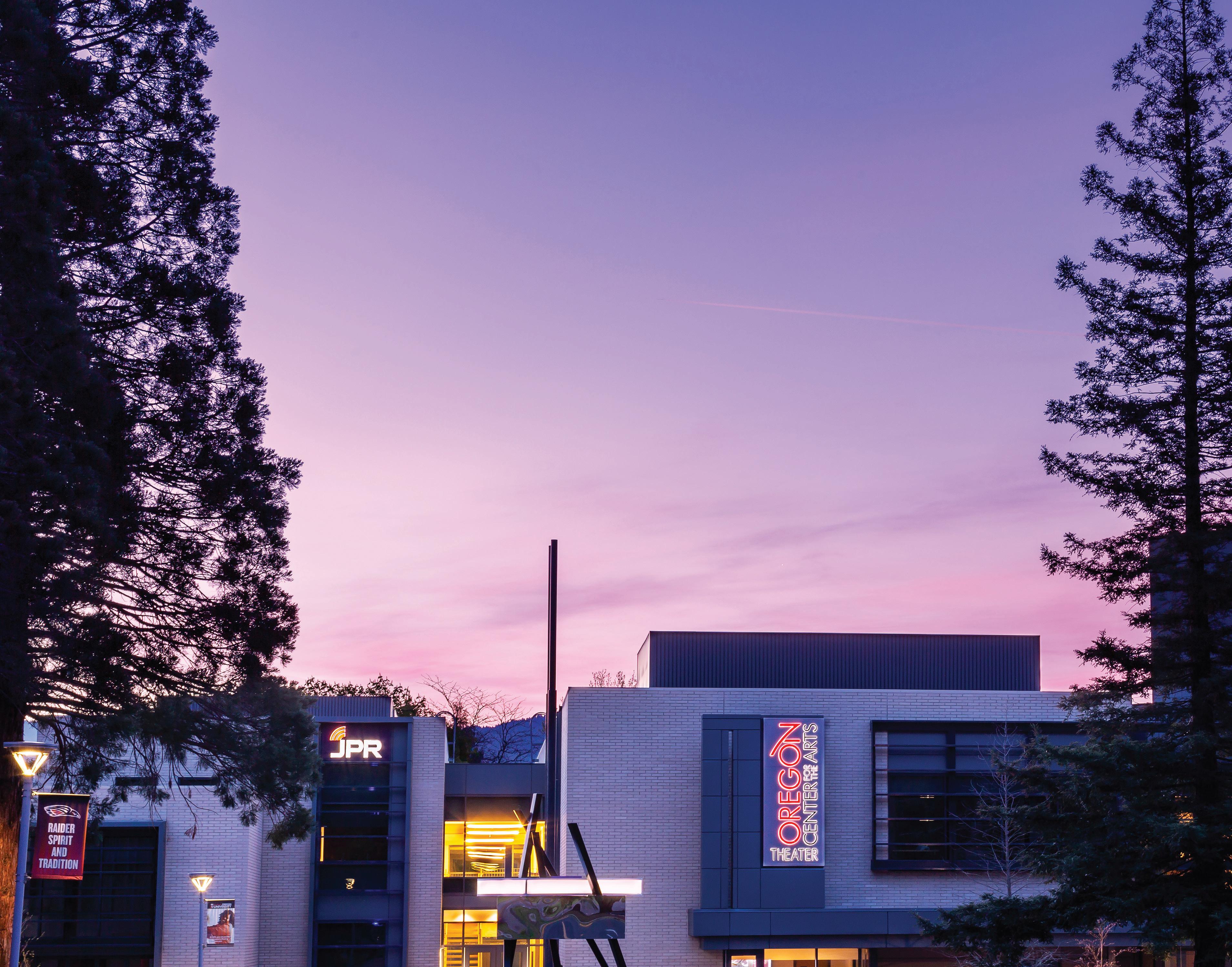




The opioid epidemic, boosted by the arrival of the drug fentanyl, has torn through communities in Southern Oregon. It’s also having a devastating impact on mothers struggling with addiction. An innovative facility in the Rogue Valley is helping those parents and their children.
When Karissa Camarillo became pregnant she was living in a tent behind a supermarket in Medford, addicted to the synthetic opioid fentanyl. She used up until the time she went into labor at a local hospital.
“I did not want my baby. I wanted to leave. I hated myself. I didn’t care. And then Kerri came in and gave me a little bit of hope,” says Camarillo.
She’s referring to the medical director for Oasis Center of the Rogue Valley, Dr. Kerri Hecox. Oasis specializes in treating parents and those who are pregnant for substance use disorders.
Hecox was at the end of Camarillo’s hospital bed when she woke up. She convinced Camarillo to enter Oasis’ program.
“I got support. I got counseling. I got forgiveness and respect, self-esteem. They helped me with everything because when I came here I was nothing,” Camarillo says. “And now I am who I am. And I’m so proud of it. And I’m so thankful for them.”
Camarillo has been clean for two and a half years now. She kept her baby.
Dr. Hecox says a clinic like this for mothers is unique. First, it doesn’t just treat someone for addiction. It also helps with the myriad of other issues they may be facing like legal trouble and food insecurity. There’s even a preschool here.
“We are coordinating all of these different pieces for families because if one of these isn’t there the family isn’t successful,” says Hecox.
Oasis is located in a one-story building by a busy freeway in downtown Medford. Inside, it lives up to its name. In its lobby is a fridge with fresh produce. There’s an area with bright carpet and toys for children. Through a gate around the back of the building is a shaded row of apartments for those that need housing.
“We’ve had probably at this point 60 people who’ve come through emergency lodging and 85% of them have gone on to residential treatment. So really, actually very good success rates,” says Hecox.
Another unique aspect of Oasis is that it offers long-term assistance. Hecox says that’s important, after all, because addiction is a long-term struggle. The center has been open for five and a half years. But Hecox says she’s seen some patients for a
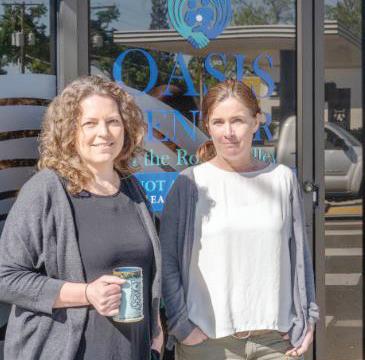
decade, beginning before Oasis opened, allowing her to watch their children grow up.
Rebecca Stone, with the non-profit Justice System Partners based in Massachusetts, says the intersection of substance use and parenting has only recently started gaining widespread attention.
Opioid-related overdoses are now a leading cause of death for those who are pregnant or those that have recently given birth.
Stone says one problem faced by that population is access to care.
“We don’t have enough treatment options for the population in need as is. There are even fewer that will take a pregnant person or allow someone to stay there with their children,” says Stone.
Continued from previous page
Another barrier, she says, is the stigma of fighting addiction while pregnant.
“This sense of shame and the sense that you might be discriminated against, the sense that you are going to get into trouble for seeking help is huge,” she says.
Many fear if they enter treatment they will have their child taken away. But Dr. Hecox at Oasis says her clinic works with child protective services and no parent that has wanted to keep their child and who has entered treatment has lost parental rights.
Some might find it incredible that individuals would use drugs while pregnant. But, according to those struggling with addiction, that’s underestimating how powerful these drugs are — especially fentanyl. Hecox says it’s changed everything.
Daphne, a patient at Oasis who wants to just use her first name, used fentanyl while she was pregnant. She’s sober now and her healthy, five-month old son is sitting on her lap.
“You want so desperately to quit. You want your baby to come out healthy and not have to go through the withdrawals and the detox. But addiction is so cunning and it wraps ahold of you,” says Daphne. “No matter how bad you want to quit, it just won’t let you.”
Karissa Camarillo, who met Dr. Hecox after giving birth, is wearing scrubs today, sitting in an office at Oasis. After becoming sober, she was hired by the center to work with other mothers.
“I love being able to see somebody come in who is like a spitting image of me. Somebody that had no hope and no love for themselves just bloom into this wonderful, beautiful person,” says Camarillo.
Having a parent using drugs greatly increases the risk their child will also struggle with addiction. Camarillo’s whole family joined the effort to save her child.
“My dad got sober for me. Same with my mother. They’re all clean and sober now. We all did it as a whole family,” she says.
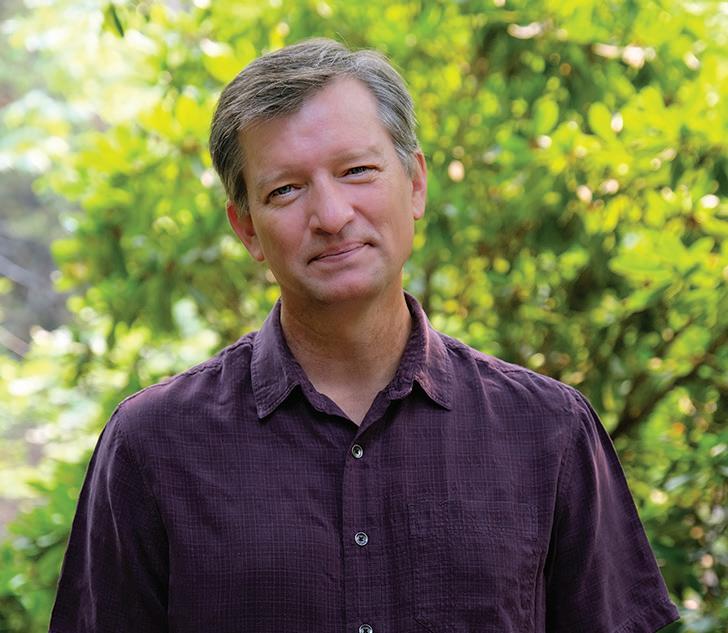
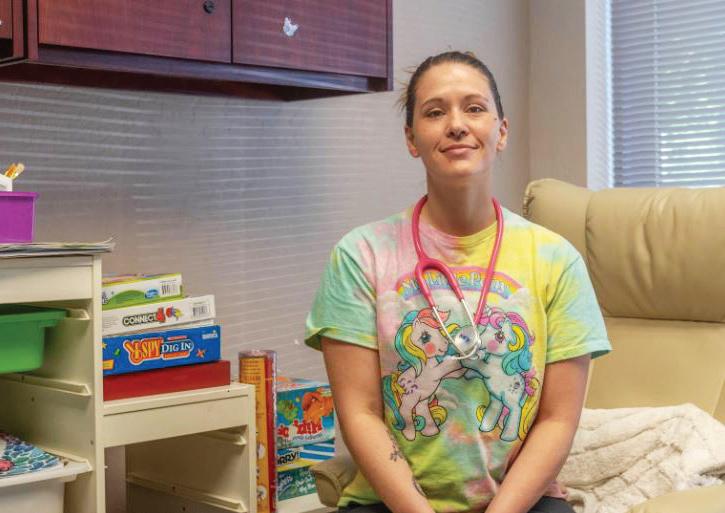
That means the staff at Oasis aren’t only helping those that walk through their doors — they’re helping their children. Their victories can’t be counted by individual cases but by generations.
Justin Higginbottom is a regional reporter for Jefferson Public Radio. He’s worked in print and radio journalism in Utah as well as abroad with stints in Southeast Asia and the Middle East. He spent a year reporting on the Myanmar civil war and has contributed to NPR, CNBC and Deutsche Welle (Germany’s public media organization).
Justin Higginbottom is a regional reporter for Jefferson Public Radio. He’s worked in print and radio journalism in Utah as well as abroad with stints in Southeast Asia and the Middle East. He spent a year reporting on the Myanmar civil war and has contributed to NPR, CNBC and Deutsche Welle (Germany’s public media organization).
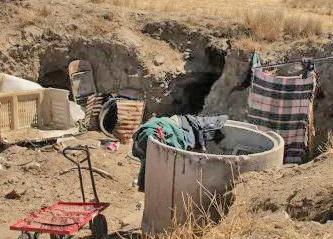
MARISA KENDALL
Doctors on the front lines of California’s homelessness and mental health crises are using monthly injections to treat psychosis in their most vulnerable patients.
As Dr. Rishi Patel’s street medicine van bounces over dirt roads and empty fields in rural Kern County, he’s looking for a particular patient he knows is overdue for her shot.
The woman, who has schizophrenia and has been living outside for five years, has several goals for herself: Start thinking more clearly, stop using meth and get an ID so she can visit her son in jail. Patel hopes the shot — a long-acting antipsychotic — will help her meet all of them.
Patel, medical director of Akido Street Medicine, is one of many street doctors throughout California using these injections as an increasingly common tool to help combat the state’s intertwined homelessness and mental health crises. Typically administered into a patient’s shoulder muscle, the medication
slowly releases into the bloodstream over time, providing relief from symptoms of psychosis for a month or longer. The shots replace a patient’s oral medication — no more taking a pill every day. For people who are homeless and routinely have their pills stolen, can’t make it to a pharmacy for a refill or simply forget to take them, the shots can mean the difference between staying on their medication, or not.
“They’ve been an absolute game-changer,” Patel said. Street medicine teams bring the shots directly to their patients wherever they are — whether it’s in a tent along Skid Row in Los Angeles, in a dugout in the middle of a field in the Central Valley, or along the bank of a stream in Shasta County. Doctors can diagnose someone, prescribe the medication, get their
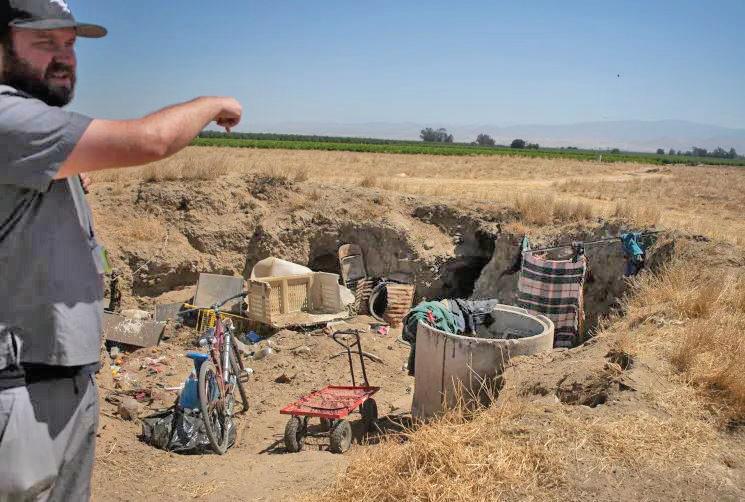
Continued from previous page
consent and give the shot within a matter of days — or sometimes even more quickly — and with minimal paperwork and red tape. They don’t need a psychiatrist’s sign-off.
It’s estimated that California is home to more than 180,000 homeless residents. How to help the sickest of them — people with severe, untreated psychosis who might wander into traffic or otherwise put themselves in danger — has become a hot-button issue, with Gov. Gavin Newsom and state lawmakers creating new and sometimes controversial ways to get people into treatment. In a recent UCSF survey of homeless Californians, 12% reported experiencing hallucinations in the past 30 days, and more than a quarter said they’d ever been hospitalized for a mental health condition.
Doctors say the goal of giving an antipsychotic shot to someone living in an encampment is to get them thinking clearly, so that they can start engaging with social workers, sign up for benefits and get on housing waitlists. While Newsom’s new CARE Court allows judges to order people into mental health treatment, and other recent legislation makes it easier to put people with a serious mental illness into conservatorships, doctors administering street injections take a different approach. The treatment is voluntary, and people can get help where they are, instead of in a locked facility.
Some success stories are dramatic. Doctors talk about patients who one day are babbling incoherently, and a week after a shot, are having conversations.
“It’s been pretty common that that’s the initiation of, ‘We’re going indoors,’” said Dr. Coley King, director of homeless health care for the Venice Family Clinic in Los Angeles. He said he’s seen dozens of patients get off the street after taking these shots.
As with any medication, the shots can have side effects. And while a patient can stop taking a pill and generally put a stop to a negative reaction, once they’ve been given a shot, they have no choice but to wait a month for the drug to wear off.
Despite some street doctors’ rave reviews, injectable antipsychotics still aren’t reaching everyone who experts say they could help. Street medicine teams report having just a handful

of patients on these medications at any one time (King’s team in Los Angeles has about two dozen). Some patients don’t want the shots, balking at the idea of having a drug in their system for an entire month, especially if they have feelings of paranoia related to health care.
And street doctors complain that hospitals still seem to prefer discharging patients from temporary psychiatric holds with a bottle of pills they may or may not take – instead of giving them a long-acting shot.
One of the biggest challenges street doctors face in administering these shots is following up with patients.
In Kern County, Patel hasn’t seen the woman he’s looking for since his team gave her first antipsychotic shot almost two months ago. Now she’s past due for another dose.
It’s worrying, Patel said, “because I don’t know how she did on it.”
The last place they saw her was at an encampment known as “The Sump” in the Central Valley farming community of Lamont, where she lived in a plywood shack along a muddy ditch behind a farm. But code enforcement recently cleared everyone out of that area, and Patel’s team doesn’t have a phone number or any other way to contact her.
The first place they look is another encampment known as “the Shrine,” because it once held a shrine to Santa Muerte, a Mexican saint of death often prayed to by drug dealers. The team drives the van through an empty field of dead, yellow grass. Several people are living in room-sized pits they’ve dug into the dirt and covered with tarps and sheets of metal. Next to the vacant land is a vineyard, with rows of vines dotted with small, green grapes.
She’s not there, so the team hands out sack lunches and bottles of water, then gets back in the van and leaves.
“We’ve seen results,” said Kirk McGowan, a street medicine nurse with Akido. “But we’ve seen more failures than successes. That’s just kind of the nature of the situation.”



In most cases, the people prescribing and administering antipsychotic shots in homeless encampments are general practice doctors — not specially trained psychiatrists. That’s because despite the growing prevalence of street medicine, street psychiatrists are still rare, according to a recent USC report.
“You look over your shoulder and there’s not a psychiatrist there helping you out,” King said. “And we want to meet the need. We want to take care of these patients. They’re really, really ill, they’re really disorganized, and suffering and dying on the streets.”
There are no legal restrictions preventing a general practice doctor from administering these injections. But some practitioners think the responsibility should be reserved for psychiatric providers.
“These medications are in there for an extended period of time,” said Keri Weinstock, a psychiatric nurse practitioner who practices street medicine in Shasta County. “They do come with risks. There are specialty things that come along with some of these specialty meds, and it’s a lot to learn when you have to know everything else, too.”
Some street doctors who give these shots seek out additional psychiatric training, while others learn on the job — often with a psychiatrist on speed dial, just in case.
“I don’t think it’s rocket science to diagnose schizophrenia, as long as we’ve done it with some thoughtfulness,” King said.
In-the-field diagnoses aren’t always clear-cut, Patel said. Sometimes, people do such a good job of hiding their symptoms that it’s hard to tell they’re dealing with psychosis. Or, instead of experiencing obvious hallucinations or other symptoms commonly associated with schizophrenia, patients experience “negative symptoms,” such as extreme social withdrawal.
When those types of cases arise, Patel calls a psychologist for a second opinion.
While these drugs are generally considered safe, they do come with a risk of side effects that can include dizziness, sedation, stiffness and decreased mobility. Those symptoms might be no big deal for someone living in a house, but for someone on the street, could be catastrophic, said Dr. Shayan Rab, a street psychiatrist with Los Angeles County’s Homeless Outreach and Mobile Engagement team. It could make someone more vulnerable to being attacked or robbed, or prevent them from accessing food or shelter.
“It’s a very serious kind of action that’s being taken and a lot of time needs to be spent before you say, ‘Hey, this individual is safe for a long-acting injection,’” he said.
To make sure a patient doesn’t have an adverse reaction, doctors typically give them an oral dose of the same medication for a few days before administering the shot.
There’s also a risk that after a street doctor gives someone a shot, that patient could later get sent to the hospital on a temporary psychiatric hold. Doctors there might not know the patient already has a long-acting dose of antipsychotic medication in their body, and might give them another dose.
Before giving someone a shot, Dr. Aislinn Bird wants to be 100% sure their symptoms are actually caused by psychotic disorder, such as schizophrenia, and not complex PTSD, major depressive disorder, methamphetamine use, or something else. Overdiagnosis of psychotic disorders is rampant, especially in the African American community, Bird said.
“You have to be sure you really know the correct diagnosis,” said Bird, who serves as director of Integrated Care at Health Care for the Homeless in Alameda County.
But Dr. Susan Partovi, who practices street medicine on Skid Row in Los Angeles, said that’s an “antiquated way of thinking.” When someone is experiencing psychosis, it’s an emergency that needs to be treated as soon as possible, no matter the cause, she said. Her preference is to treat the symptoms first, and then see if the patient wants to work on other issues, such as substance use.
Antipsychotic injectables, such as Abilify and Invega, tend to be most prevalent in street medicine practices. But street doctors also administer long-acting injectable HIV medication, as well as medication for addiction such as Vivitrol — an injectable, long-acting medication that can help reduce cravings for opioids and alcohol, and protect against overdose.
Ricardo Fonseca Jr., who goes by “Ricky,” has been homeless for two years, living in a tent behind a Dollar Tree, then in a park in rural Kern County. The 31-year-old said he was working as a welder until he had a sudden mental breakdown and started hearing voices.
The voices said horrible things to him. Sometimes they yelled, and he yelled back, scaring those around him. He used methamphetamine to cope.
“It was getting to the point where I just felt like killing myself,” Fonseca said.
Two months ago, Fonseca started taking a monthly shot of the antipsychotic drug Abilify. Since then, “everything’s changed,” he said.
Now, Fonseca is staying at a friend’s house and considering going to school. He says he’s stopped using meth.
“I can finally hear the birds and the crickets,” he said. “I couldn’t hear them before.”
CalMatters is a nonprofit, nonpartisan media venture explaining California policies and politics.

Marisa Kendall reports on California’s homelessness crisis for CalMatters.
“We try to stay involved in a lot of different community programs because one of our goals is to add more diversity in the media and film industry.”
Co-founder of digital creative agency Black Cub Productions

“I found my [1978 BMW R80/7] in an old shed, just sitting there abandoned… a mechanic went through it and restored it. I rode it for a good ten or fifteen years. I had a number of more modern machines but didn’t like them that much, so I reverted back to the old style.
I started riding in Germany way back in the 1950s and travelled all over Europe. I shipped [a motorcycle] back to New York and rode it to Mexico and then to Alaska. The Alcan Highway wasn’t paved in those days. We were in Fairbanks the day statehood was declared so everyone was partying all night.

I’m a fifty-five-year motorcycle rider and no longer wish to ride. I wanted to give [this motorcycle] a good home. I’m just so fond of JPR, so I thought ‘why not?’. I go to sleep listening to JPR’s Classics & News service around midnight and wake to the morning news. [This donation] will help continue their good work.”

On June 17, dozens of property owners crowded into a room at the Jackson County Expo in Central Point to learn about the revised map, which will be available for public comment in July. The open house was one of six planned for “high hazard” communities across the state.
The initial map, released in June 2022, was quickly withdrawn after widespread public outcry. The revamped version includes several major changes. Two hazard categories have been eliminated; now, properties will be grouped in one of three hazard zones: low, moderate, or high.
Irrigated croplands and pasture lands were also reassessed. In Josephine and Jackson County, corridors along creeks now show up as green—low hazard—rather than orange or red.
“The change better reflects how on pasture lands and hay lands, fuel is only seasonally available,” said Andy McEvoy, wildfire researcher at the College of Forestry at OSU, which developed the map. “The effect is to reduce the hazard on these lands.”
A low hazard designation doesn’t mean that a fire can’t happen there; instead, the categories will help the state prioritize high-hazard neighborhoods and communities for mitigation.
“We’re trying to get ahead of a really significant problem that is already here that we’re already seeing in California,” said Chris Dunn, professor at Oregon State University’s College of Forestry. “It’s starting to take communities out and it’s starting to impact our insurance markets, which is a collective resource that we all buy into.”
Two of the concerned property owners at the open house were Maxine Cass and her husband, Fred Gebhart, who live on their 20-acre property in Sams Valley in Jackson County, north of Medford.
They were there to learn about the status of the map and “if and how and when our insurance rates might be affected,” said Cass. They received a letter informing them that they were in the “extreme” or highest hazard category when the map was initially released in 2022. An Oregon law passed in 2023 explicitly prohibits insurance companies from using state wildfire hazard maps to raise rates, cancel policies, or refuse to renew coverage, but Cass and Gebhart don’t see how it can be enforced.
The hazard map is a mandated outcome of SB 762, which was passed in 2021 a year after Oregon’s destructive Labor Day fires. OSU researchers created the map using two data sets: burn probability, or the likelihood that a fire will occur, and “fire intensity,” or how much energy a fire produces. These met-
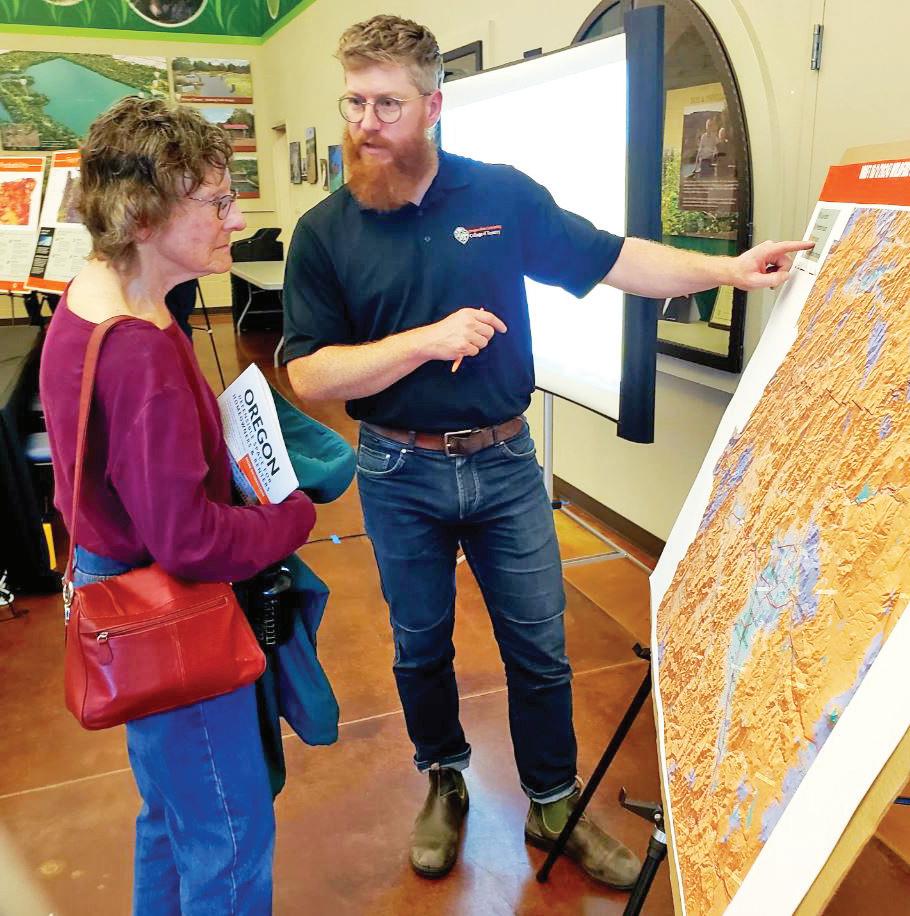
rics in turn are based on four factors: climate, weather, topography and vegetation.
What the map doesn’t do is adjust a property’s hazard category based on steps an individual property owner may have taken, such as replacing a roof or removing vegetation from immediately around buildings.
The legislation also calls for the Oregon State Fire Marshal, or OSFM, to create a defensible space code and for the Building Codes Division to adopt “fire hardening” building code standards. Only properties designated as high hazard that are wholly or partly in the Wildland-Urban Interface–defined generally as the zone between developed and vegetated land–will be impacted by the new codes.
OSFM is taking an “educational over enforcement philosophy” around defensible space, said Chad Hawkins, assistant chief deputy at OSFM’s Fire Life Safety Division. The agency offers a free property assessment through its Defensible Space Program, which is carried out by local fire departments or OSFM personnel.
Continued from previous page
The fire hardening code will only apply to new construction or upgrades on an existing home, such as replacing a roof or siding.
Dunn, who led the science team that developed the map, admits there was a “complete disconnect” on how to engage the public during its initial roll-out in 2022. People were confused about its purpose and alarmed by the official letters informing them of their hazard category.
“The narrative became, my insurance is getting dropped or going up; my home values are going down; and I’m going to have to spend $100,000 on my property,” said Dunn. He hopes that improved communication along with an improved map will help Oregonians consider how their properties fit in context with the “fire landscape” and what they might do to mitigate their vulnerability.
“The map is the beginning of the process, not the end,” said Dunn.
A public comment period on the draft rules governing the map will run from July 1 to August 15. Public comment on the draft map itself will be accepted between July 18 and August 18. The finalized map will be published online on October 1.
and improved Oregon wildfire hazard map is coming.
Those in high-hazard zones whose properties are also within the WUI will be notified by letter. All property owners will have until October 15 to appeal their property’s designation.
Juliet Grable is a writer based in Southern Oregon and a regular contributor to JPR News. She writes about wild places and wild creatures, rural communities, and the built environment.

Juliet Grable is a writer based in Southern Oregon and a regular contributor to JPR News. She writes about wild places and wild creatures, rural communities, and the built environment.




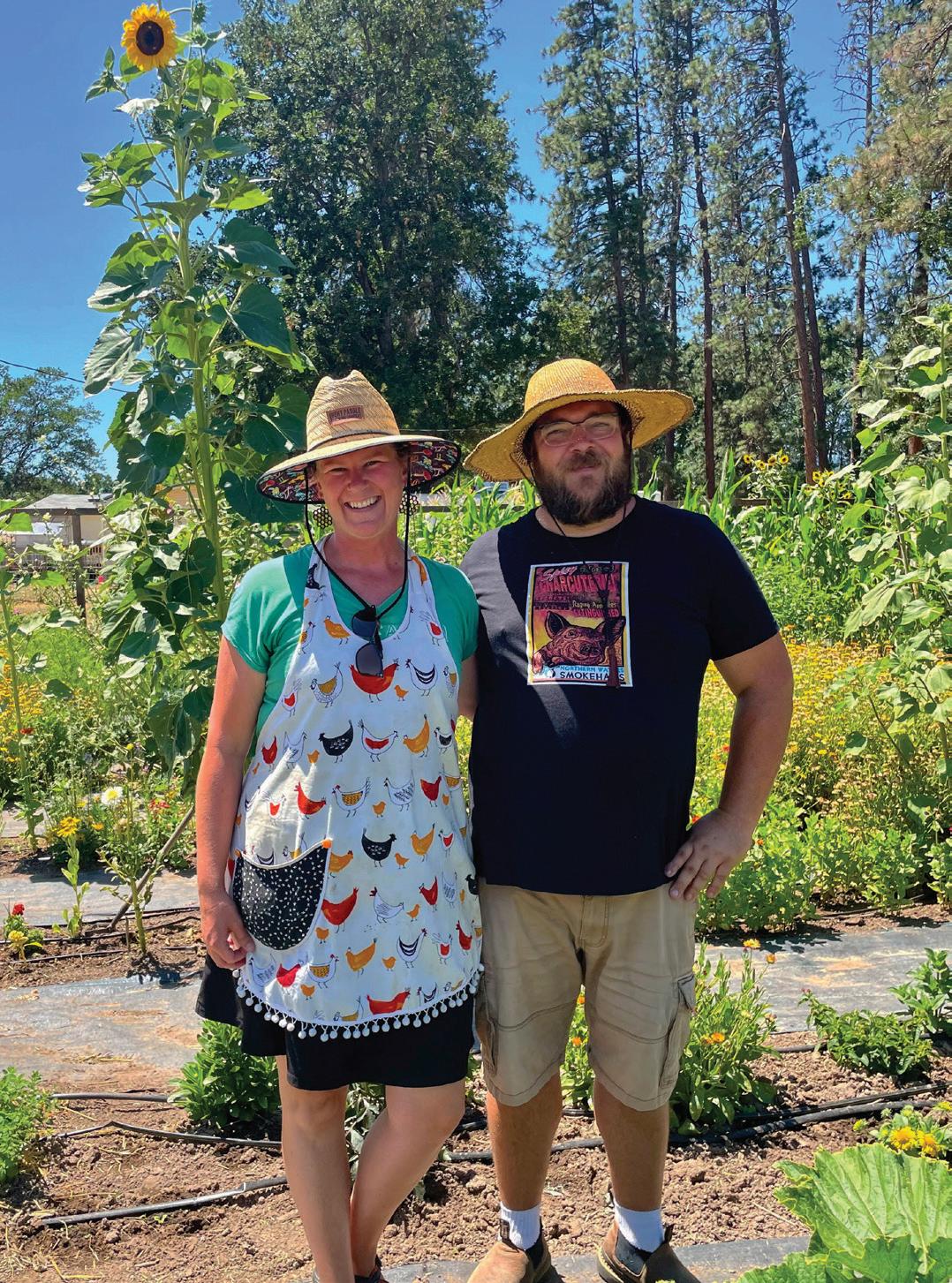



JES BURNS
The Pacific Northwest has three distinct populations of orcas living off its shores. The residents, the transients and the offshores. They have different ranges, dorsal fin shapes and markings. They eat different kinds of food and even speak different languages.
But growing evidence suggests that there could be a fourth distinct population, or ecotype, living in the deep ocean off Oregon and California. Now researchers from the University of British Columbia have collected 25 years’ worth of sightings to understand the range and other distinctive characteristics of these “oceanic” whales.
The 49 new orcas — observed by researchers, fishermen and birders over the years — don’t match individuals in any other population. They have been witnessed hunting a fullsized sperm whale, in addition to other large ocean mammals.
Wounds from cookiecutter sharks seem to be a calling card for the new oceanic population. These small sharks live way offshore in the open ocean and bite round cookie-shaped chunks out of larger fish, sharks and marine mammals. Most of the new orcas have evidence of these bites, leaving the researchers to conclude the whales spend most of their time in deep water.
The paper was published in the journal Aquatic Mammals

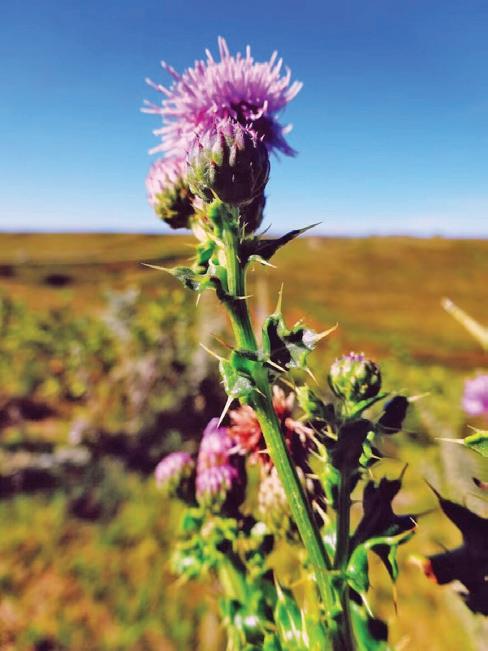
Since the mid-1970s, the herbicide glyphosate (aka Roundup) has been one of themost widely-used weed killers in the world. The Environmental Protection Agency has maintained that glyphosate doesn’t pose a significant risk to human health or the environment. Yet recent challenges to those findings have been successful in court. Roundup producer Monsanto (now Bayer) has started offering billions of dollarsin settlements to people who used the herbicide and subsequently developed certain cancers.
All this to say, the future of glyphosate is uncertain, and we might be cleaning it up from the environment, including our drinking water, for decades to come.
Now researchers at Oregon State University have discovered a way to break down and remove glyphosate from groundwater. They’ve identified a specific material that can break down glyphosate into non-hazardous substances through a reaction triggered by light.
The material, consisting of metals and organic compounds bound together, has the ability to remove glyphosate from water in just five minutes.
The results were published in the Nature Communications
Genetic technology has come a long way in a short period of time. But an area where researchers haven’t fully cracked the code is creating viable human embryos that don’t require the strict sex-based combination of an egg and sperm.
Now researchers at Oregon Health & Science University have developed a way to combine genetic information to produce a viable egg — regardless of the parent’s reproductive sex or medical ability to have children. The process still requires sperm to create a viable embryo, but the egg can be created using skin cells from anyone.
Scientists developed the technique using cells from mice.
Continued from previous page
They stripped the genetic information from a viable egg cell (kind of like taking out the software, but leaving the hardware behind) and injected that egg with chromosomes extracted from a skin cell. The researchers then coaxed the new skin cell-egg hybrid to drop half its chromosomes, making it ready to be fertilized by sperm through in vitro fertilization.
The technique is still far from being ready for use with humans, but it offers a new avenue for male samesex couples and infertile women to conceive children related to both parents.

photo from OHSU shows Paula Amato, M.D., professor of obstetrics and gynecology in the OHSU School of Medicine, and Shoukhrat Mitalipov, Ph.D., director of the OHSU Center for Embryonic Cell and Gene Therapy on Aug. 4, 2022.
The paper was published in Science Advances
Despite concerted efforts to throw the doors open for women and underrepresented BIPOC communities to pursue science, technology, engineering and mathematics (STEM) careers, there is still a wide gap in representation in the workforce. Researchers at the University of Washington are looking for ways to offer education opportunities specifically tailored to inspire these groups to thrive in STEM fields. They’ve developed a course that uses embroidery to teach basic concepts behind computer coding. The researchers say embroidery has natural links to coding because of the pixel-by-pixel and repetitive nature of the stitching. Through the embroidery, they were also able to offer a cultural connection for students not often present in STEM courses.
The high school students started by learning how to hand-embroider and spent time studying different cultural traditions of embroidery (Mexican, Arab and Japanese) from around the world.

University of Washington researchers taught a group of high schoolers to code by combining cultural research into various embroidery traditions with “computational embroidery.” The method teaches kids to encode embroidery patterns on a computer through a coding language called Turtlestitch. In this photo released by the University of Washington, a student stitched plants with code, then hand-embroidered a bee.
COURTESY OF KIVUVA ET AL./SIGCSE
They were then introduced to an open-source web app called TurtleStitch, which is used to “code” patterns for embroidery machines. The class spent several weeks working on designs, while learning coding concepts like loops and functions. The lead researcher plans to adapt the program further for different ages and experiences.
This research was published in the Proceedings of the 55th ACM Technical Symposium on Computer Science Education.
People in the United States love decks. We use more than 3 billion linear feet of decking boards each year. In recent years, there’s been a slow shift from wood decking to composite boards, which can be made of recycled plastic and wood fillers. The new composites are more expensive but last longer and require less maintenance.
Now researchers at Pacific Northwest National Lab are adding “carbon negative” to the list of benefits of composite boards.
They’ve developed a new formulation of composite that uses lignin or lignite (both organic industrial waste products) instead of more typical fillers like wood flour. To get the lignin/ lignite to bond with the plastic, the scientists created a reaction that attaches carbon dioxide to the surface. In the end, the filler material ends up being up to 5% CO2 by weight.
If manufactured using green methods, the researchers say the material will be carbon negative over its lifetime — a rare thing when it comes to building materials. In addition, the researchers say the material would actually be cheaper to manufacture than traditional composites, and its strength meets international building code standards.
The research was presented at the spring meeting of the American Chemical Society.
Update: “The solution to climate change is rural America.”
Back in 2022, “All Science. No Fiction” featured research about a new paradigm in green energy production. Scientists at Oregon State University were working on ways to fully integrate agriculture and solar power production on the same plot of land in a way that’s mutually beneficial to both.
One of the scientists featured was trying to figure out what mix of pasture plants would be best for grazing lambs around solar power arrays, given the need for the plants to perform well when shaded by the panels. Now she’s published the results in the journal Grass and Forage Science.
Implementing agrivoltaic systems would be a significant shift in the way we approach green energy production and agriculture as a society. Nitty-gritty research like this is vital to provide the information farmers need to make a paradigm shift.
In this monthly rundown from OPB, “All Science. No Fiction.” creator Jes Burns features the most interesting, wondrous and hopeful science coming out of the Pacific Northwest.

CHELSEA
ROSE
Unless you have been living under a rock, you will have been inundated with dire headlines, terrifying statistics, and direct evidence of warming and increasingly unpredictable weather. We’ve all had a front row seat as the climate crisis morphed from a theoretical discussion to an acute situation. And it is terrifying. We had a conversation about these fears with Todd Braje, author of Understanding Imperiled Earth: How Archaeology and Human History Inform a Sustainable Future (Smithsonian Books, 2024), on a recent episode of Underground History. Braje’s very approachable and public-oriented book bravely tackles this daunting subject and forces us to think bigger and broader about this unprecedented moment in time by highlighting the ways in which humans have always had to adjust, pivot, and evolve to keep up with the changing world around them.

Oregon archaeologists have had a front row seat to many of these historical changes. We have documented ancient sites in the eastern desert that were once lakeside abodes, charted how a river changing course could have a dramatic impact on available resources, and we’ve had plenty of catastrophic floods, fires, and tsunamis. And yet people lived, endured, and sometimes thrived. In short, while the planet has never been exactly here before, society, culture, and day to day life have been impacted by the need to course-correct in order to survive for millennia. According to Braje, we don’t need to reinvent the wheel, we can look to the past for guidance.
You don’t have to dig very far (or even touch a shovel) to find evidence of environmental change across the globe. Braje’s
book looks at wild birds and tuna markets and even has a fascinating chapter using the lack of timbers available for the restoration of Notre-Dame as a launching point to explore European deforestation over the last 800 years. We have always been impacting and impacted by the natural world. The Industrial Revolution just supercharged the impact.
During our conversation I asked Braje about a particularly terrifying section of the book, wherein he describes how we are living within a sixth mass extinction. Loss of biodiversity has devastating consequences for humans (and plants and animals…), but this time, our nightmare has a silver lining. Unlike the dinosaurs who were just minding their own business when an asteroid ruined the party, humans have caused our current predicament (or at least greatly contributed), and therefore humans control some of the factors that can be used to reverse or mitigate it. For the many folks that have been ringing alarm bells for decades this is nothing new, but perhaps more people are ready hear it and make meaningful changes—or as Braje encourages, to embrace uncertainty and take bold action. With unseasonably high temperatures fire season looming, I know I’m ready.

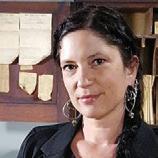
Chelsea Rose is an historical archaeologist and director of the Southern Oregon University Laboratory of Anthropology (SOULA). She is a principal investigator in the award-winning Oregon Chinese Diaspora Project (OCDP) and is host of the award-winning Underground History podcast, a monthly radio segment on JPR's the Jefferson Exchange.
jazz sunday
12:00pm on jPR’s Rhythm & news Service



For over two decades, The Folk Show has featured an eclectic blend of all things folk and some things not-so-folk. Singer/songwriters, Americana, bluegrass, Celtic, traditional, old-time, and some surprises are featured each week.
Hosted by Frances Oyung, Cindy DeGroft, Robin Terranova, Taurie Michelle, Eric Houghton, Noah Lindsday.
Sundays 6pm–9pm
JPR’s Rhythm & News Service www.ijpr.org

Oregon had 610 retail pharmacies statewide as of February, amounting to just 14.4 pharmacies per 100,000 people.
Oregon has the second fewest retail pharmacies per capita in the nation — with poorer access to pharmacies than any state except Alaska, according to a new analysis by the Associated Press.
The AP obtained proprietary data from the National Council for Prescription Drug Programs, a standards development group for the pharmacy industry.
Oregon had 610 retail pharmacies statewide as of February, amounting to just 14.4 pharmacies per 100,000 people.
And that number is falling, according to Brian Mayo, executive director of the Oregon Pharmacy Association. Thirty-six pharmacies closed last year, and several more have closed so far in 2024.
“With how few pharmacies Oregon has, every pharmacy should be considered a critical access pharmacy,” Mayo told OPB.
The AP’s tally does not include hospital inpatient pharmacies or mail-order pharmacies.
Chain pharmacies are also more common in Oregon than other states and independently-owned pharmacies are rarer here, the analysis found. Seventy percent of retail pharmacies in Oregon self-identified as being owned by a chain, compared to 61% nationwide.
Murray’s Drug is a small independent pharmacy chain that largely serves patients from frontier counties, areas with six or fewer people per square mile. Murray’s is headquartered in Heppner in southern Morrow County, but its service area extends into zip codes that are either underserved or have no pharmacies whatsoever.
“The towns of Arlington, Irrigon and Umatilla do not have pharmacies anymore,” said Ann Murray, who co-owns Murray’s Drug with her husband John. “Even Hermiston is overwhelmed with the chains going out (of business).”
Many of the economic challenges pushing pharmacies to close aren’t unique to Oregon. Across the U.S., more than 7,000 pharmacies have closed since 2019, according to data from University of Pittsburgh researcher Lucas Berenbrok, who considers that estimate conservative.
An industry that saw waves of store growth before the COVID-19 pandemic faces headwinds like falling prescription reimbursement, persistent theft and changing shopping habits. Those challenges have created an incentive for retail giants to shutter underperforming brick-and-mortar drug stores and push mail-order services, according to Mayo.
“It’s a way for them to be more profitable,” he said.

The Murrays were also skeptical of mail order pharmacies’ effectiveness in rural Oregon. While Murray’s Drugs runs tri-weekly deliveries to several communities with no pharmacies, Ann Murray said mail order pharmacies cannot offer the same level of service for illnesses that require quick turnaround prescriptions like COVID-19 and the flu.
The closures in Oregon — and nationwide — have also brought scrutiny to the opaque system that sets drug prices and determines how much pharmacists make dispensing them.
Most insurers rely on intermediaries known as pharmacy benefit managers to negotiate prices and decide what drugs are covered for millions of Americans.
It’s a highly consolidated industry: the three largest PBMs control about 80% of the marketplace. What’s more, those PBMs are themselves subsidiaries of several of the largest vertically integrated health care companies in the country: CVS Health, UnitedHealth Group and Cigna.
A recent audit by the Oregon Secretary of State suggested that one reason chain pharmacies have been able to outcom-
Contribute at least $60 annually, or become a sustainer with ongoing monthly contributions of any amount. Do your part to support public radio in southern Oregon and northern California and you'll also receive an annual subscription to the Jefferson Journal.
Please fill out the form below and mail it to: Jefferson Public Radio Attn: Membership 1250 Siskiyou Blvd Ashland, OR 97520 Contributions can also be made online at ijpr.org/support
Enclosed is my gift for $___________. The JPR services I enjoy are:
Continued from previous page
pete independent pharmacies is because they are subsidiaries of those same health care giants that use their pharmacy benefit managers to negotiate favorable reimbursements with insurers.
National chains, the audit found, were reimbursed twice the amount that independent pharmacies were for selected drugs reviewed in the audit.
Independent pharmacies have long lobbied the Legislature for more transparency in the PBM industry, and to curb the losses felt by pharmacies due to PBM’s reimbursement policies.
Earlier this year, Oregon lawmakers passed legislation to tighten regulations around PBMs, requiring them to be licensed by the state among other rules. Independent pharmacies felt that the bill was watered down and want to return with stronger legislation in 2025.
The Murrays said PBMs are the primary reason pharmacies are closing around Oregon. And they anticipate more pressure from expected lower reimbursement rates from Medicare Part D, the insurance program’s prescription plan.
John Murray predicted Oregon’s pharmacy closure problem to get worse without further government action.
“There’s going to be a tremendous storm coming for Medicare plans and pharmacy coverage,” he said.
The Associated Press contributed to this report.

Join Host Geoffrey Riley and Producers Angela Decker & Charlie Zimmerman for in-depth conversations about the issues and ideas vital to our region.
Weekdays – Live 9–10 AM Rebroadcast 8–9 PM Jefferson Public Radio’s News & Information Service



A Nature Notes Sampler II is a broad collection of radio com mentaries based on Dr. Frank Lang’s popular series that aired on JPR since the publication of the first volume in the year 2000. This collection of es says offers Dr. Lang’s same eclectic, often humorous view of the natural world in the mythical State of Jefferson and beyond. Over 100 of Dr. Lang’s commentaries have been collected in this second vol ume. Make it your first collection of Nature Notes, or add it to the original publication for a complete set!
Order A Nature Notes Sampler II for $19.95 postpaid.
Where There’s A Will There’s A Way! Our Gift To You...
JPR now offers a free online tool that enables you to create a legally valid will, completely free of cost.
This tool is for individuals who want to proactively manage their financial future, take care of loved ones, and have an opportunity to contribute to community organizations that reflect their lifelong values. The platform makes it easy to put your intentions and priorities on paper... and all it takes is about 20 minutes of your time (and no obligation to contribute to JPR).
Go to iJPR.org/make-a-bequest to learn more, and get started today!



Victoria cake is a classic English dessert that sandwiches fruit preserves and whipped cream between two layers of airysponge cake. It inspired these individually sized, poppy seed-flecked cakes that are baked in a muffin pan, then are splitand filled after cooling. Bonne Maman Lemon Curd is swirled into the whipped cream, and Bonne Maman RaspberryPreserves are used straight up—a little of each go inside the cakes and are dolloped on top, too. If convenient, the bakedand cooled cakes can be stored in an airtight container in the refrigerator for up to three days, but be sure to bring themto room temperature before splitting and filling them. They’re best served right away, or within an hour of assembly. Produced by Milk Street for Bonne Maman. Don’t use the four center cups of the the muffin pan. The eight outer cups get better air circulation aroundthem for more even baking and better browning. Also, don’t overblend the wet ingredients or the cakes willbake up with bubbly surfaces. Blend only until the ingredients are well combined, about 15 seconds, and besure to scrape the blender jar to ensure the sugar isn’t clumped on the side.
MAKES 8 INDIVIDUAL CAKES 50 MINUTES PLUS COOLING
120 grams (1 cup) cake flour
1¼ teaspoons poppy seeds
½ teaspoon baking powder
¼ teaspoon baking soda
¼ teaspoon table salt
½ cup buttermilk, room temperature
70 grams (5 tablespoons) salted butter, melted and slightly cooled
1 large egg, plus 1 large egg yolk, room temperature
1 teaspoon vanilla extract
107 grams (½ cup) white sugar
½ cup cold heavy cream
3 tablespoons bonne maman lemon curd
3 tablespoons bonne maman raspberry preserves
Fresh mint, for garnish (optional)
Directions
1. Heat the oven to 350°F with a rack in the middle position. Generously mistthe outer 8 cups of a standard 12-cup muffin pan with cooking spray.
2. In a medium bowl, whisk together the flour, poppy seeds, baking powder,baking soda and salt. In a blender, combine the buttermilk, butter, whole eggand egg yolk, vanilla and sugar. Blend on high just until combined, about 15seconds, scraping the jar halfway through to make sure the sugar has notclumped on the sides; do not overblend. Pour the wet ingredients into the dryingredients, then whisk just until evenly moistened. Scoop the batter into theprepared cups of the muffin pan, dividing it evenly. Rap the pan 2 or 3 timeson the counter to remove any air bubbles.
3. Bake until the cakes are light golden brown and a toothpick inserted at thecenters comes out clean, 12 to 15 minutes. Cool in the pans on a wire rack for5 minutes. Run a paring knife around the edge of each cake to loosen. Liftthem out of the pan and set directly on the rack. Cool completely.
4. When you are ready to finish the cakes, in a medium bowl and using a handmixer or whisk, whip the cream until softpeaks form. In another mediumbowl, stir the lemon curd until loosened. Add about 3 tablespoons of thewhipped cream to the curd and, using a silicone spatula, gently fold until justthe mixture is lightened and lightly streaked. Add the remaining whippedcream to the lightened curd and fold until the mixture looks swirled.
5. Using a serrated knife, slice the cap offeach cake where it meets the sides; setthe caps aside. Spread 1 teaspoon raspberry preserves on the cut side of eachcake base. Dollop 1 tablespoon whipped cream onto the preserves on eachcake. Place the caps gently on top; do not press them down.
6. Dollop the remaining whipped cream onto the center of each cake (about 1tablespoon each), creating a cloud-like puff. Using the back of a small spoon,make a shallow indentation in the center of the whipped cream. Spoon ½teaspoon of the remaining preserves into each indentation. Garnish eachcakes with mint (if using). Serve immediately or refrigerate, uncovered, forup to 1 hour.
KIM KELLY
On the hunt in balmy Palm Desert
The Angel Store called to me For Carol Channing somethings. The Grand Dame of the desert
Had recently passed on to a wider stage. Her minders and friends sifted through All her possessions I am sure Until there remained only well worn items the kind that frugal nonagenarians have. And there they were: Carol Channing’s scuffs.
Label-less, but they gently spoke to me of keeping her feet cozy; Mid-aged themselves and heavily padded. Nonchalantly, I tucked those scuffs under my arm and held them close fearing a tackle by another tourist intent upon ripping them from my possession. I perused further into the store. Ah, three martini glasses— well worn and fragile and speaking of a different era, just like Carol.
I took them to the register for safe keeping And moved through the space, searching . . . Alas, nothing else spoke to me. Arriving to pay, the martini glass caretaker allowed that she had broken one. And was unapologetic. The old shoes were dearer than I wanted But then they were their own kind of priceless. Back out into the heat I went, Clutching Carol Channing’s scuffs.
Writers may submit original poetry for publication in Jefferson Journal
Email 3–6 poems, a brief bio, and your mailing address in one attachment to jeffmopoetry@gmail.com , or send 3–6 poems, a brief bio, and a self-addressed, stamped envelope to:
Amy Miller, Poetry Editor Jefferson Journal
1250 Siskiyou Blvd
Please allow eight Ashland, OR 97520 weeks for reply.
250 of us in a dated courthouse Winnowed down to 50.
Escorted into the quiet room that holds court
Over us all.
Wires snake from computers across the floor
To a central brain.
I focus on the court reporter
As the only interesting thing to watch. We wait for the judge until The command “all rise” and we respectfully stand. Non-sensical opening from the offense. Can people make a living by this?
I am freezing so cross my arms To keep warm.
And I frown as I concentrate on every word. The court reporter animates. Her eyes closed, fingers flying With a Mona Lisa smile as if in conjugal bliss. Are others seeing this obvious Ecstasy?
The 12 of us sit in the box and the reporter Waxes poetical, eyes closed. Or are they?
A fifteen minute break. I alone stay. The attorneys confer.
Questions are asked of us.
I frown and wear emotions on my freezing sleeve.
“Juror 38, dismissed,” says the judge.
I am so dumbfounded, he has to repeat.
Scooching by fellow jurors, emotions are mixed.
I want to serve but I am cold.
I walk out into the summer heat and begin to thaw.
Kim Kelly is an insurance agent living in Eugene, Oregon, by day and a writer by what is left of the day. She collaborated with singer/songwriter Ann Hampton Callaway on a post-Covid poem, “Our Stories are Back.”


The Holly Theatre in Medford is nearly finished and it’s going to be beautiful — just like when it opened back in 1930. We just received a $50,000 matching challenge from a generous anonymous donor and we need your help to meet the challenge.
To open the Holly by January 2025, we need to raise the final $660,000 in order to furnish the theater with seats, theatrical lighting, sound and projection equipment, rigging, concession equipment and soft goods, including the grand drape for the stage.
Any donation will be matched 1:1 until the matching challenge is met. Would you be able to help us reach our goal?
Please see hollytheatre.org to make your contribution. Any amount will do and donations of $500 or more can be paid over a 3-year period.
If you don’t see an option that’s right for you, or if you have questions, contact us at info@jeffersonlive.org or call (541)772-3797 x512 for details and answers.













